I think green curry is the best-known curry in Thai cuisine, although I personally think Massaman and Panang are quite famous on their own, to the point where I don’t even know which one is the close second. But rest assured, if you haven’t reached the point where you’re ready to barf curry before the year end (because I will be giving you recipe after recipe of curries through out the year,) I will give you a medal, accept your “Thai-ness” and appoint you an official “adopted Thai peep.” How is that?
This is the second curry that I learned to make while I was growing up. We made it ourselves because it contains fresh chilies and it doesn’t taste anywhere near as fresh if you buy the pre-made curry paste. My grandmother and my aunt always said I could buy some pre-made curry pastes if I wanted to, but there are three curry pastes (the Thai call them “Krueang Kaeng” เครื่องแกง or “Nam Phrik Kaeng” น้ำพริกแกง, which is shortened to “Phrik Kaeng” พริกแกง these days) that I shouldn’t buy:
1. The sour curry, Kaeng Som แกงส้ม
2. The green curry, Kaeng Khiao Wan แกงเขียวหวาน
3. The most important to the Southern Thai people, the yellow sour curry, Kaeng Lueang แกงเหลือง.
The flavor of these three curries relies upon the freshness of the ingredients and wouldn’t be used even the next day (though I found it still acceptable).
The green curry has an official name in Thai called “Kaeng Khiao Wan,” meaning “the sweet green soup.” Kaeng=soup, Khiao=green, Wan=sweet. It is a misunderstanding even among the Thai that this curry should be sweeter than most because its name mentions sweetness…WRONG! The sweetness or “Wan” referred to in the Thai name is in reference to the color, not the taste. The correct place to apply the sweet concept is to the color green.
The color should be peaceful, mild, dreamy, creamy, sweet green. So you’re making a savory, mild green soup, but not a sweet soup. In fact, this is the most spicy, the hottest Thai curry because it contains fresh chilis, unlike all other curries, which will use dried chilies.
The source of the green color comes from the fresh green chilis and NOT ANY OTHER FOREIGN GREEN LEAVES, as I mentioned earlier in my “What It’s Not?” blog on Thai curry. If you desperately need to make your curry look greener (as is true in my case because I can’t put so much chili in my curry paste or in my digestive tract) I do use chili leaves or Thai basil leaves to help pop the color green up a bit.
Remember you SHOULDN’T PUT THOSE LEAVES IN THE CURRY PASTE ITSELF but should puree them with water and then strain the leaves out, keeping the green water and adding it to the curry right before you turn off the heat.
Why add at the end? Because those leaves are so sensitive to heat they will change color as soon as it touches them. And if you cook them too long they turn brown. This is also the reason why we don’t add them to the curry paste, which has to be cooked for so long. Also, a curry paste that contained these leaves would not store very long.
This post is going to be quite detailed about each ingredient and how to properly prepare them. I’m not going to do this in every curry post, so it’s going to serve as a basic guide for all the other curry recipes on my blog.
Get to know the ingredients.
Lemongrass: This is an ingredient that is available throughout the country now that Gourmet Garden started putting lemongrass in a tube. Or you can find it in the fresh herb section in the supermarket. This makes cooking truly authentic Thai food quite accessible. I’ve seen it in many major cities. Also Trader Joe’s, Ralph’s, Gelson’s, and Bristol Farms in California, and Whole Foods in most major cities in the US carries it too.
I hope it will soon be available in the regular supermarkets all over the country. If you can’t find it in the market, you also can buy it online now. Temple of Thai, Frieda’s and Amazon carry it.
I know I can’t use Rhode Island as a gauge for the whole US, but in my mind, (the mind of a girl from Bangkok, you know, might be drastically different than a normal American girl’s), Rhode Island, the state where my French Canadian-descent husband came from, is so suburban. It’s borderline “country.” I’m only waiting to see a cow crossing the highway to classify any town in the state as real “country”. If there is only a chicken or turkey crossing the road, the state is only borderline country.
Anyhow, if I can find lemongrass at Whole Foods in Rhode Island, I believe that you can find it somewhere in your town. If worst comes to worst, buy the puree in the tube from the Gourmet Garden. Just make sure you DON’T follow their PadThai recipe. It’s one of the WORST stir-fried noodle attempts at PadThai.
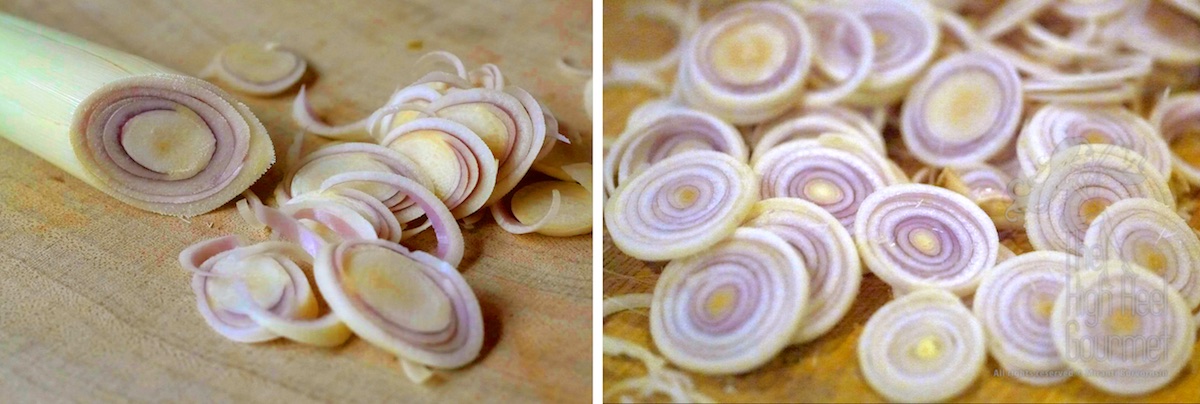
These are the parts that we use for the curry paste. The middle is thick, with purple rings surrounding it.
The part of lemongrass that we use in Thai curry paste is only the part that has the purple rings, about 3-4 inches above the root. When you buy them long like in this picture, you can only use one third to half of the stem. Do not discard the tops–we can still use them in many other things, like Tom Yum soup, Tom Kha soup, salad, etc., so save them.
Lemongrass is really hard so you want to slice it thinly, making it much easier to puree either in a blender or with a mortar and pestle. And if you can’t find lemongrass, then you are NOT going to be making true Thai curry paste using any substitution.
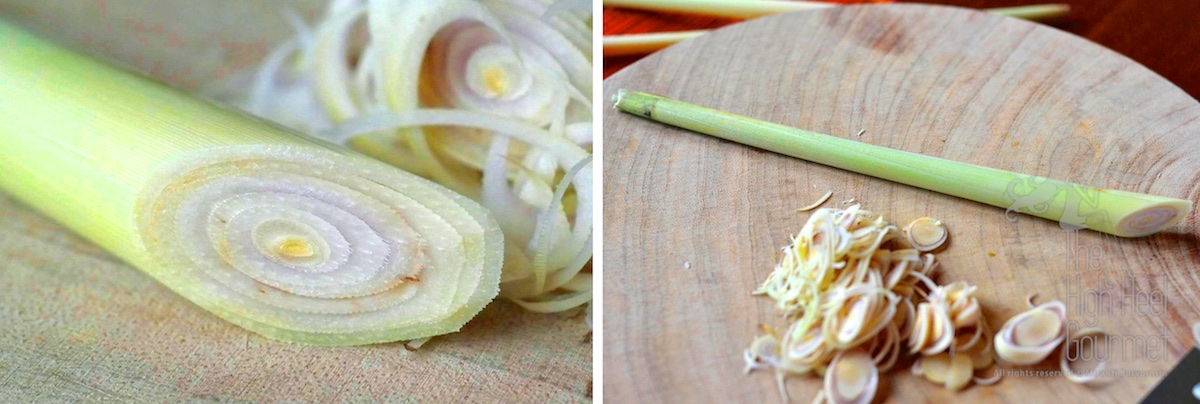
These are the parts that we don’t put in the curry paste but save for other use. The left picture shows when to stop slicing the stalk. The right shows how long a piece we bought.
Galangal: This is not that easy to find, but not too hard since Asian groceries usually carry it. If you can’t find an Asian grocery in your town, try Temple of Thai, or Amazon. It is a root of plants in the “Zingiberaceae” family, same as ginger, but it looks somewhat different than ginger.
And it tastes drasticaly different than ginger. You almost never eat galangal raw like you eat ginger. It taste rather bitter, the texture is woody, and gives quite an earthy, citrus-y aroma instead of fresh, crunchy, sweet, and spicy like ginger. The older galangal has a more woody texture.
If I were in Thailand I would prefer the older galangal for the curry paste and the younger one for the galangal soup or Tom Kha recipe, which I already posted here. Since I’m here and galangal isn’t that that easy to find, I take it both old and young. (Like my men!) It is also sold pre-sliced and frozen. I’ll use that if I can’t find the fresh one.
Galangal is called “Kha” in Thailand. So now you know and I hope you will NEVER SUBSTITUTE GALANGAL FOR GINGER (called “Khing”) IN ANY RECIPE, especially in Tom Kha soup.
I’ve found a lot of recipes out there on the internet claiming to be a “Thai Tom Kha soup,” but they used ginger as a substitute for galangal. Sorry, people, we don’t call a coconut soup boiled with ginger “Tom Kha” when it’s missing the “Kha,” alright? I hope you won’t be offended by THAT fact, and please stop calling it by the wrong name. If you want to, call it Tom Khing without adding the word Thai, then we won’t bitch about it, even though that Thai dish DOESN’T even exist!
What should you do if you can’t find fresh or frozen galangal root? DON’T MAKE FRESH CURRY PASTE UNTIL YOU CAN FIND IT. Buy the pre-made curry paste for now. Remember, we’re making the Thai curry paste so it will taste fresh and better than the “pre-made in the can” one. If you can’t make it better, why sweat?
Garlic: I shouldn’t have to explain much about this herb. One note about the source: I had been using the pre-peeled garlic in a package, available in most Asian markets. I seriously suspect this garlic is imported from China! I had a hard time making a beautiful golden fried garlic with it and so I started using California garlic that I have to peel myself and voila…there was the golden crispy fried garlic I wanted.
I don’t know if it was because the garlic in the package was a different species or they peeled them many days before I purchased it (don’t forget the packing and shipping time too) or you don’t even know what’s going onto that garlic in China. Simple solution: I stopped using it.
Shallot: Use small bulbs; they are more pungent. And try your best NOT to substitute with onion. Okay, the problem with onion is just the milder aroma, so you have to use a lot in order to get it to balance. The more you use onion the sweeter your curry will be and it would be a nightmare to grind them in a mortar with a pestle because it will splash right in your face and eyes.
Also, the curry will come out smelling more like Indian curry. If you’re somehow resourceful enough to find galangal and lemongrass but can’t find shallots, you’re just giving up too easily!
Cilantro (coriander) root: This is a hard one to find. I can’t even bribe anyone at the market here to save them for me because they get their cilantro with the root already chopped off. So nowadays I buy the frozen cilantro (coriander) root that is imported from Thailand. If you ask your local produce grocer to save you the roots, they might do it for you.
I used to ask the Mexican markets in San Francisco and Las Vegas to save them for me. They will sell them to you cheap, but the way they come usually looks like a pile of dirt that you have to sort through. You will have to wash the dirt off over and over again. Then use bicarbonate of soda (baking soda) to clean them in the last washing round, then use a knife to scrape the skin off the roots, then cut them into small pieces.
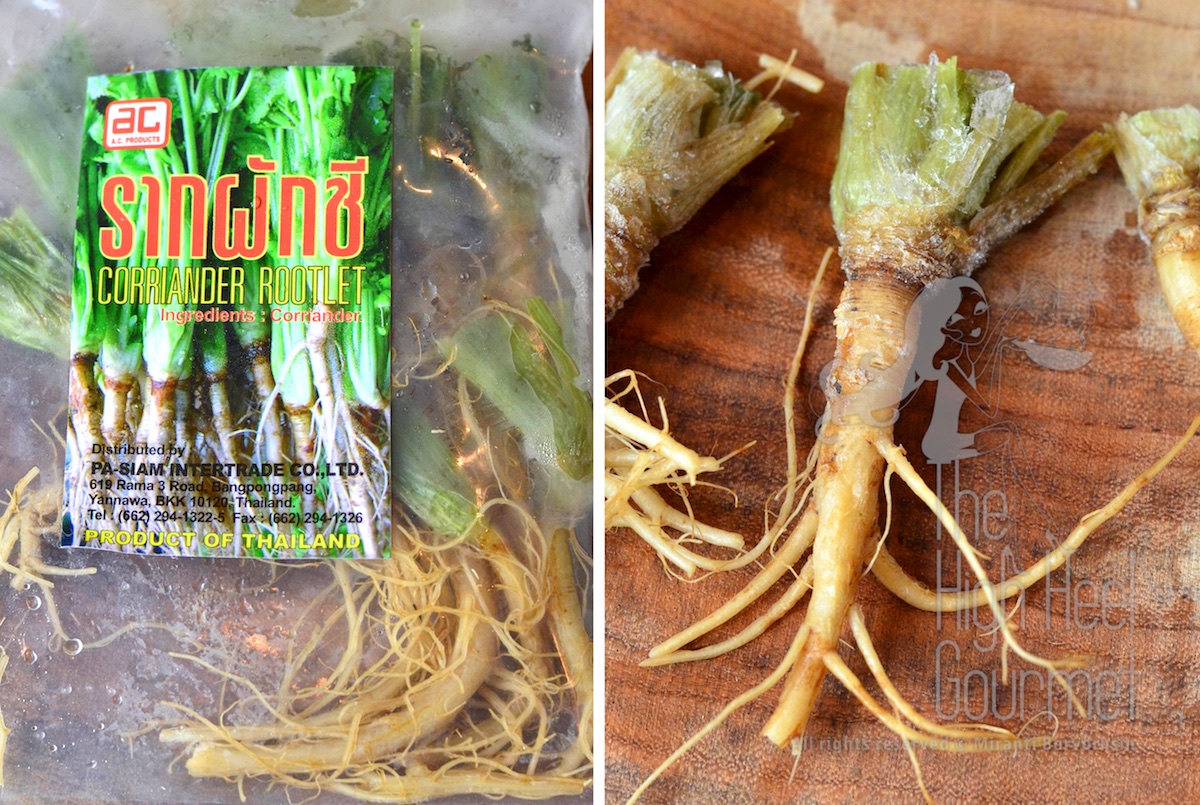
Left: Bag of frozen coriander. Right: The root is ready to be used. I normally scrape the skin off the root first.
I even heard of someone growing their own cilantro just to get the root. I admire this person a great deal. If I could find a place to turn my black thumbs in for new green thumbs, I would start doing that too.
If you really can’t find it, use the cilantro stems, the part nearest the root, not longer than two inches up. The higher you go on the cilantro stem, the more it loses the earthy pungency and enters the greeny arena, so you don’t want to use that.
If you don’t have the root and need to substitute with the stem, use the same amount that the recipe calls for. Do not increase the quantity because you’ll end up adding the green leafy smell to it, too.
Kaffir Lime Zest: Out of all ingredients, this will be the most difficult one to find! Yeah, like the formers are already easy…I’m sorry, guys. These ingredients are so easy to find in Thailand. I would say, other than garlic and shallots, the rest of the ingredients already grow in the back yard of my urban home in Bangkok, including Kaffir lime!
I usually buy imported whole Kaffir lime frozen from the Thai market, but you can try Temple of Thai, but they are not always in season. You can buy them in season and peel the zest and freeze them to use all year long.
Occasionally I’m lucky and my tiny Kaffir lime tree at home gives me fruit. It’s just not enough to make curry paste all year long. My witch (bitch) magic isn’t strong enough to make my Kaffir lime tree grow faster or yield more fruit. It has been four years since I planted it, but it’s not even my height (not tall) yet. I’ll be lucky to harvest 2-3 fruits in a year.
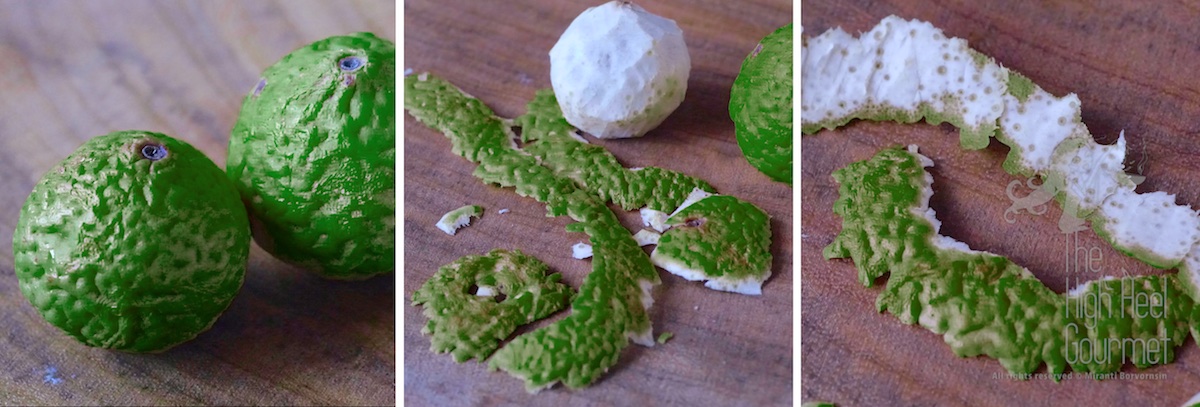
Left: My small backyard kaffir limes. Middle: Peeled zest from the lime. Try to leave the white out as much as possible. Right: That’s the amount of white I left on the zest.
When you peel the Kaffir lime to get the zest, try to get only the green part and not the white part. The white part is bitter. You would do the same with regular lime zest.
This is where I’ll allow you to use regular lime zest mixed with Kaffir lime leaf (which is easier to find) in this proportion; lime zest : Kaffir lime leaves, 2:1, starting with half the amount of zest as the zest called for in my recipe. (In other words, if I use 1 teaspoon Kaffir lime zest, then you would use 1/2 teaspoon of lime zest and add 1/4 teaspoon of Kaffir lime leaf, chopped finely.)
Shrimp paste: This is a very important ingredient. Without it, it’s not Thai curry. It is the source of the umami flavor. To the people who weren’t born eating Thai food all the time, it smells like fermented rotten seafood, but it smells so good to me!
All of the curry ingredients are intended to cover up the smell of the meat in the curry. If the meat is beef (considered the strongest smell), then we add more spice such as coriander seed, and cumin too (I will talk about that spice later). If the protein is fish, then we add more lemongrass and galangal just to cover up the fishy smell.
You might already have a question in your mind, “Why the hell does she put that stink bomb sauce in there? If all the herbs and spices are just to cover up the meat’s strong smell, adding shrimp paste defeats the purpose!”
Well as I said before, not to the Thai. The shrimp paste is to “round up” all the aromas and add the umami taste to the paste and to the finished curry. Originally, when the Indian curry came to Southeast Asia, the curry paste didn’t include shrimp paste, but the Southeast Asians couldn’t resist adding this familiar taste to the curry, as you will see in Massaman curry paste recipe.
Massaman curry is the oldest type of curry paste and also the closest to the original Indian curry. I do have two Massaman curry recipes here; one is the Beef Shank Massaman, another is the Cornish Game Hen in Massaman with the recipe for Massaman curry paste.
Shrimp paste has many different brands and origins. You can buy it from these same places I keep sending you to, Temple of Thai or Amazon. I’m used to the type that is made with small shrimp, from a province near the sea, in the far south of Thailand–Songkhla–where my parents were from.
I love the shrimp paste from there the most, but it’s also the one I’m most used to. That’s the only shrimp paste known in my and most of my relatives’ households. (Most of them are from that same province.) But I can’t buy it in the US since they don’t export it. They barely make enough for the local people there.
I can hardly find it in Bangkok. I have to go visit my relatives down in Songkhla and buy it there and carry it to the US. I normally carry at least a pound or two into the country.
Once, a long time ago, as I was coming through LAX, the customs officer noticed the fishy smell from my luggage and asked if he could take a look at what was inside. Of course, I let him search though 4-5 pounds of dried shrimp, 4-5 pounds of dried fish, a pound or two of salted fish (equally as stinky as the shrimp paste), marinated fish stomach (Tai-Pla ไตปลา), and a full 2 pounds of shrimp paste!
I warned him, but he didn’t listen to me. I normally wrap the packages with many layers of plastic bags and foil to protect my clothing from the pungent aromas, and that was a red flag to the customs officer. He needed to see what was inside. As layer after layer of the wrapping materials were peeled, the stronger and stronger smell came out…whifffff…the officer face didn’t look too good. I bet he was close to throwing up, but he was persistent. Okay…go ahead. You want me to open the containers to dig around inside them, too? Sure.
Hahahaha, at the end of the search session, he was looking sick. Well, I warned him at every step. There was only ONE reason why I wrapped my packages really tight in many layers. That’s the first clue, man.
He even asked if I planned to sell the goods I brought. Hell NOOOOO! NO ONE could offer me enough to sell those precious goods…I was about to explain that, but then I saw he had only asked to fill in his form, and he actually didn’t really want to talk or let any more of the fishy stink go any deeper into his nostrils. I think he remembered that experience for a long time.
The pictures below show you the difference between my favorite kind, regular Songkhla shrimp paste, and the best Rayong shrimp paste (Rayong is another province in the East that makes good shrimp paste. This is the kind that you can find in Bangkok.) and the shrimp paste by Pantainorasingh brand that you can find here in the US. This brand adds MSG to the shrimp paste! I normally don’t buy any shrimp paste in the US, but someone gave me this and it sat in my pantry for a while.
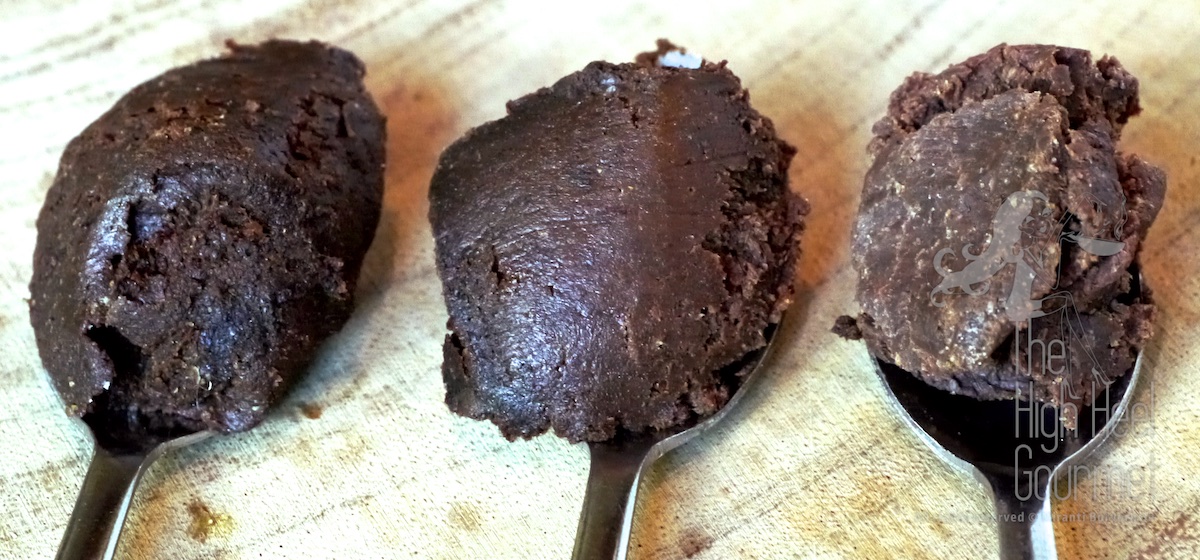
Left: Songkhla Kapi from the South. Middle: Rayong Kapi from the East. Right: Pantainorasingh Kapi (MSG loaded); if you have no choice, this is it.
Before use, you should wrap the shrimp paste in foil, or banana leaf if you can find it, and set it on the grill or on the stove to cook it first.
If you are vegan or vegetarian, you can substitute the shrimp paste with Vegemite or Marmite, using the same measured portion.
Once you know all of the ingredients, now we can put together the curry paste. The proportions I give you here are just a guideline. It all can be varied based on your taste and the meat you choose. I vary the amount of the ingredients all the time. They are all FULLY FLEXIBLE, meaning you can add or subtract several ingredients as you prefer (The add-on list is down below; and don’t forget the “What it’s not.”)
There are only fives ingredients that you can’t completely eliminate: Green Chilies, Lemongrass, Galangal, Shallot, Garlic, Shrimp Paste. Other than that, you can even eliminate some hard-to-find ingredients completely and the curry will still taste okay, even to the Thais.
Example of how I altered the ingredients:
• When I have a cold, I double the shallots portion.
• When I make fish curry, I double the lemongrass and add slightly more garlic and galangal and a teaspoon of turmeric, too (Southern style green curry).
• When I make beef curry I double the spices, cumin and coriander seeds or even a pinch of nutmeg or mace are welcome in this case.
• If I cook for people who will go out to a club later, I reduce the garlic.
You can get rid off the Kaffir lime zest and cilantro root completely and the result will still be alright. I suspected that my aunt’s green curry that I liked so much had absolutely no spices, coriander seeds and cumin, but turmeric was a regular ingredient in all her curries. Green curry that has turmeric blends well with all kind of fish and seafood.
I also listed the potential additions down below, in case you want to explore. This is the perfect recipe for me for the basic chicken curry.
Once I grind them to a paste, I then smell the blend of the ingredients and adjust the amount to get the balance, but it’s probably impossible for you to do so. I suggest you at least make this recipe once, so you would know what it supposed to smell like. Then you can try and adjust the amount of ingredients to your preference later.
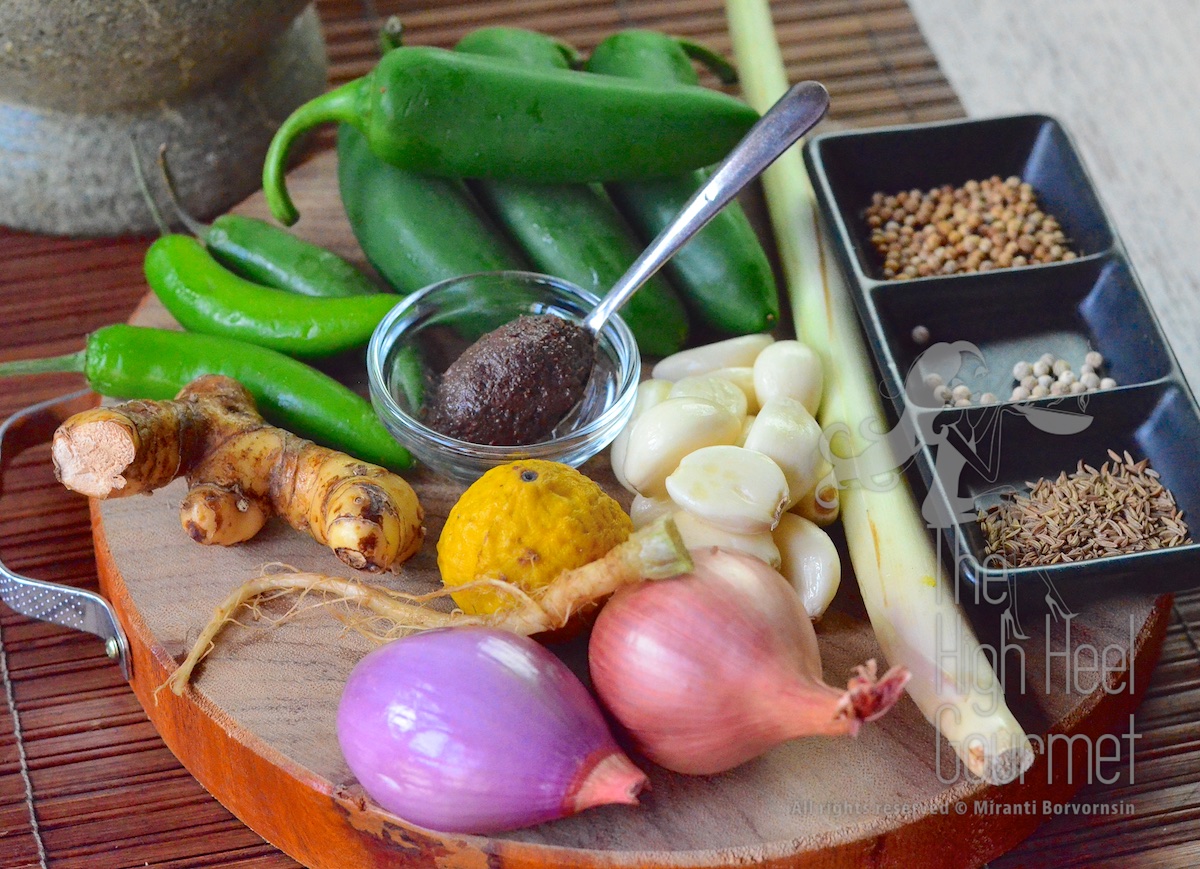
Clockwise from the center: Shrimp paste (in the glass cup), Garlic, Shallots, Coriander root, Kaffir lime (only the zest will be used), Galangal, Serrano chiles, Jalapeño chilies, Lemongrass, Coriander seed, White peppercorns, Cumin seeds
Many people ask me “What’s the RIGHT balance?”
You will reach the right balance when the curry paste you made has a whole aroma, and you don’t smell the particular ingredients anymore. This is the only answer I keep giving to everybody. It’s hard to achieve, I understand, especially when you didn’t grow up smelling curry paste or eating curry all the time.
You can start practicing by sniffing ALL of the ingredients and remembering the aroma of each one of them. That at the least will help you to identify when one ingredient sends a stronger aroma, overpowering the others.
Warning: You will NEVER be able to control the strength of every ingredient just by measuring. Older galangal, younger lemongrass, juicy shallots, dried garlic–all of them give out different strength of their aromas. The only way to achieve the balance is to have good nose.
Ingredients
Galangal root, sliced thinly or chopped, 1 tablespoon
Lemongrass, sliced thinly 2 tablespoons
Garlic, sliced 6 tablespoons
Shallots, sliced 5 tablespoons
3 serrano chiles
4 large green jalapeno chilies, seeded
Coriander root chopped 1 teaspoon
Kaffir lime zest 1 teaspoon
Salt 1 teaspoon
Shrimp paste, roasted 1 teaspoon
White Peppercorns 1/2 teaspoon
Coriander seed, roasted 1 teaspoon
Cumin roasted 1 teaspoon
Coconut oil, vegetable oil, or coconut milk, if you are going to use a food processor or blender.
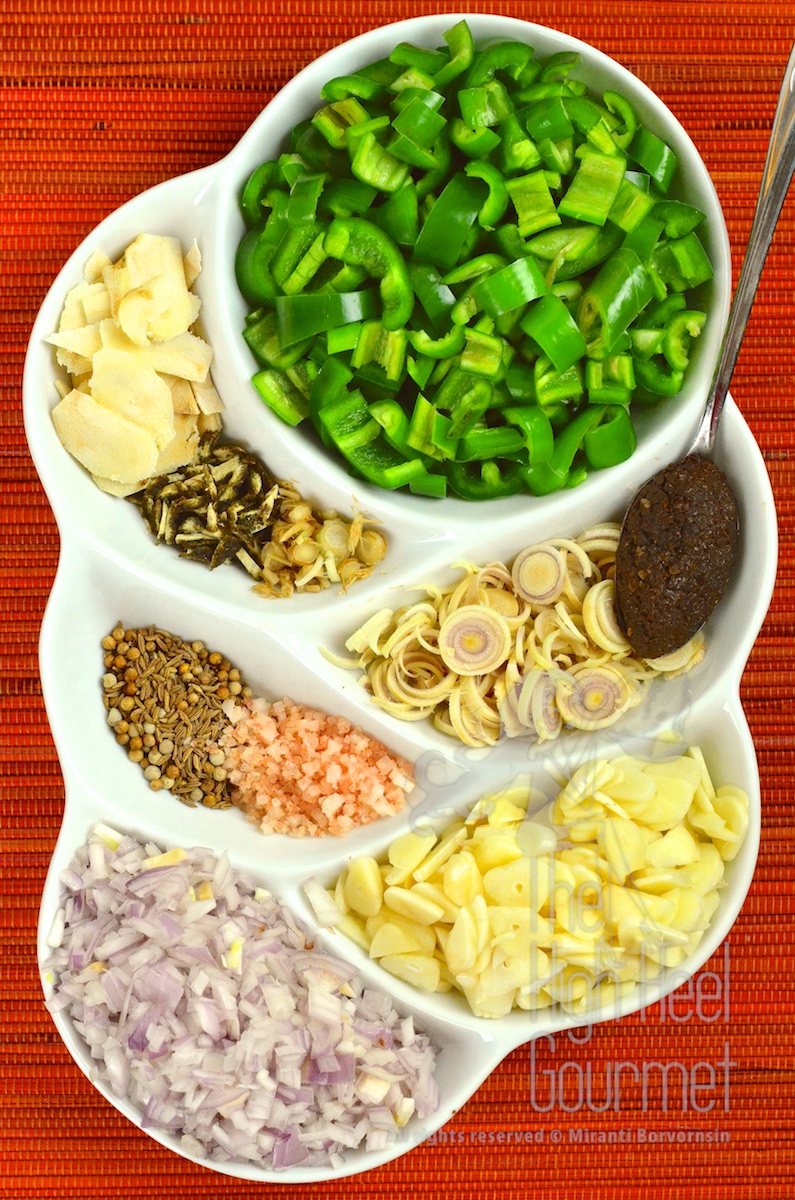
From top: Green Chiles, Galangal, Kaffir lime zest, Coriander root, Lemongrass, Shrimp paste, Coriander seeds, Cumin, White peppercorns, Sea Salt, Garlic, Shallots
Method
There are two methods that I use to make a paste out of these roots and seeds, which at first don’t look like they would turn into a paste that easily.
1) First is using a blender, either a Vitamix (the best because you don’t have to add a lot of liquid to make it blend), a Cusinart, which is the one I expect to be most similar to what you have in your kitchen, or any blender powerful enough that you can crush ice with it. You can use either the traditional tall blender or a food processor.
The tall blender that you use to make margaritas will require more liquid to process (unless you use a Vitamix). I normally use that for the curry paste for Kaeng, or the soup kind, so I can add more liquid to help the grinding.
I use coconut cream as the liquid with this green curry paste, if I want to cook the whole dish right away AND cook with coconut milk. You might need up to half a cup or more for this curry, but I never use more than half a cup with my Cusinart. You might have to help it a little by turning the bottom up to the top by using the “ice crush” button sometimes.
If I want to keep it longer and store it outside the fridge, I recommend using a Vitamix or any high-powered blender or food processor which requires less liquid to process. With a Vitamix I don’t use any liquid for the green curry, but use 1/4 cup of liquid (at the most) for the other curry pastes.
My Vitamix grinds really fast, under 5 minutes, and you get a very smooth curry paste, so it’s worth half a grand to me (or more). If you don’t have a Vitamix, that’s alright, most food processors will do the job at one-tenth the price, but it will take longer. I usually grind it in the food processor for 10 minutes and finish it in the blender.
The food processor take less liquid to move the ingredients around and chop them finely, but to make them all smooth I have to transfer it to the blender and might have to add a little more liquid to it.
If you use this method, grinding the spices, coriander seeds, cumin and white peppercorns in a coffee grinder first would make it easier to make your curry paste smooth. (Keep a coffee grinder to use solely to grind spices; do not use it to grind coffee after. No matter how thoroughly you clean your coffee grinder after this, the smell will stay and will ruin your coffee.)
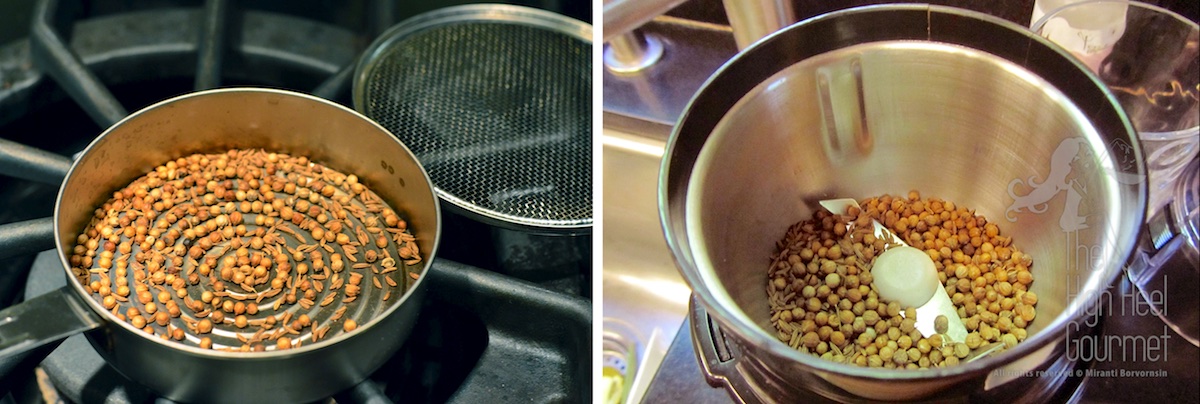
Roast them over medium heat until they release the aroma before grinding them in the coffee grinder.
Then add everything in together and start grinding. Stop the machine every two minutes to let the the machine motor rest to prevent overheating. I use coconut oil as liquid so it mimics the traditional process. I also cook the curry paste in that oil before packing it in a clean jar while it’s still hot, and then process the jar in boiling water the same way I do when finishing jam jars.
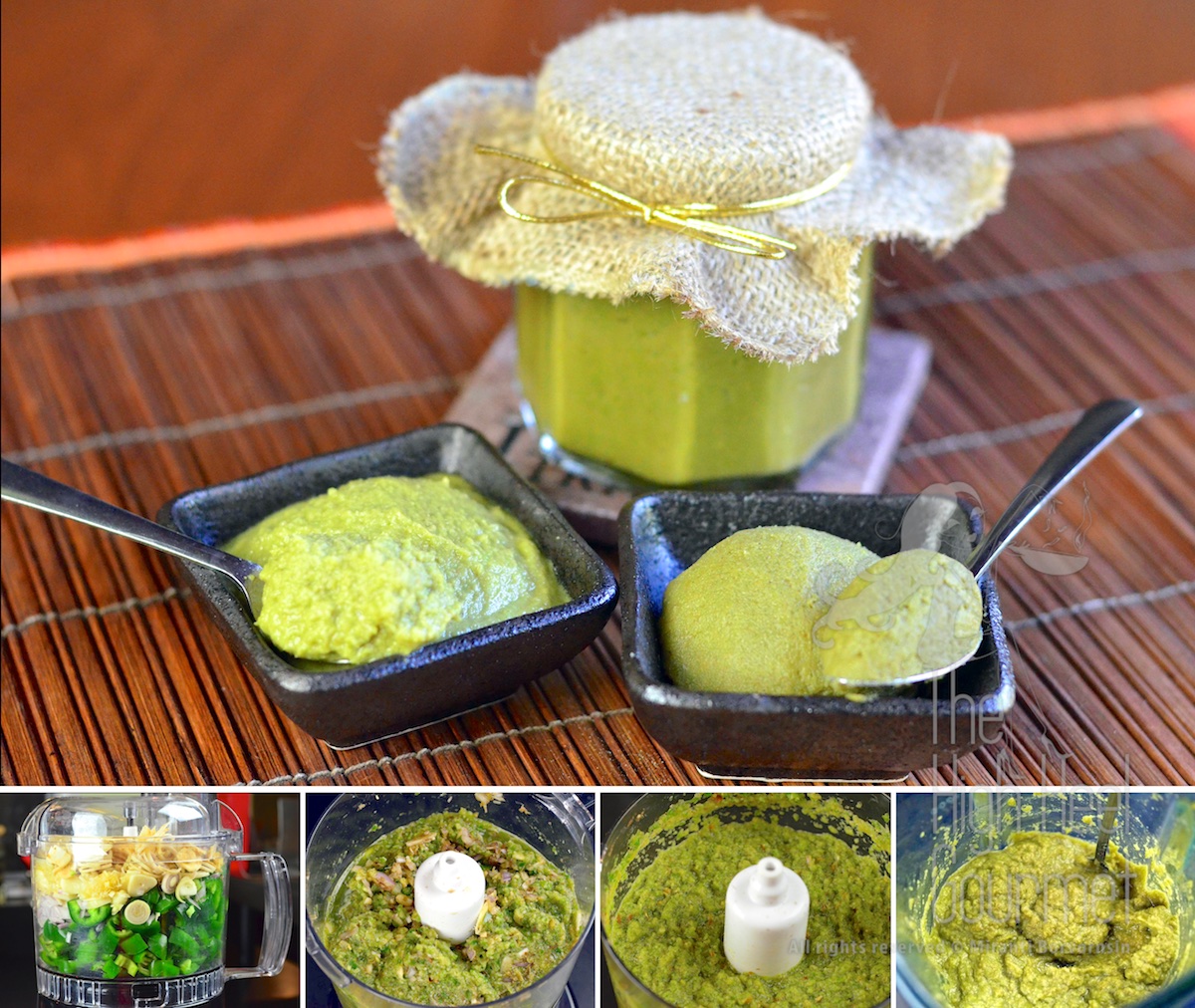
The paste in the cup on the left was just fresh out of the blender. This is the best to make Thai green curry soup with, but it keeps in the fridge only a week at the most. (I never tried keeping it longer since normally it would gone before a week.) If you want to keep it longer, you can cook just enough to sterilize all the ingredients. The curry paste in the cup on the right was fully cooked and ready to pack in a jar.
2) The second method is to grind the ingredients the traditional way, with a mortar and pestle. In the picture below are two different kind of mortars. The granite one is the ONLY one appropriate for making the curry paste.
If you have the terra-cotta one that comes with a wooden pestle, you will not be able to make a good curry paste with it, or your curry paste will be very coarse, which my aunt would snobbishly call “country style,” despite the fact that SHE was the one living in the country.
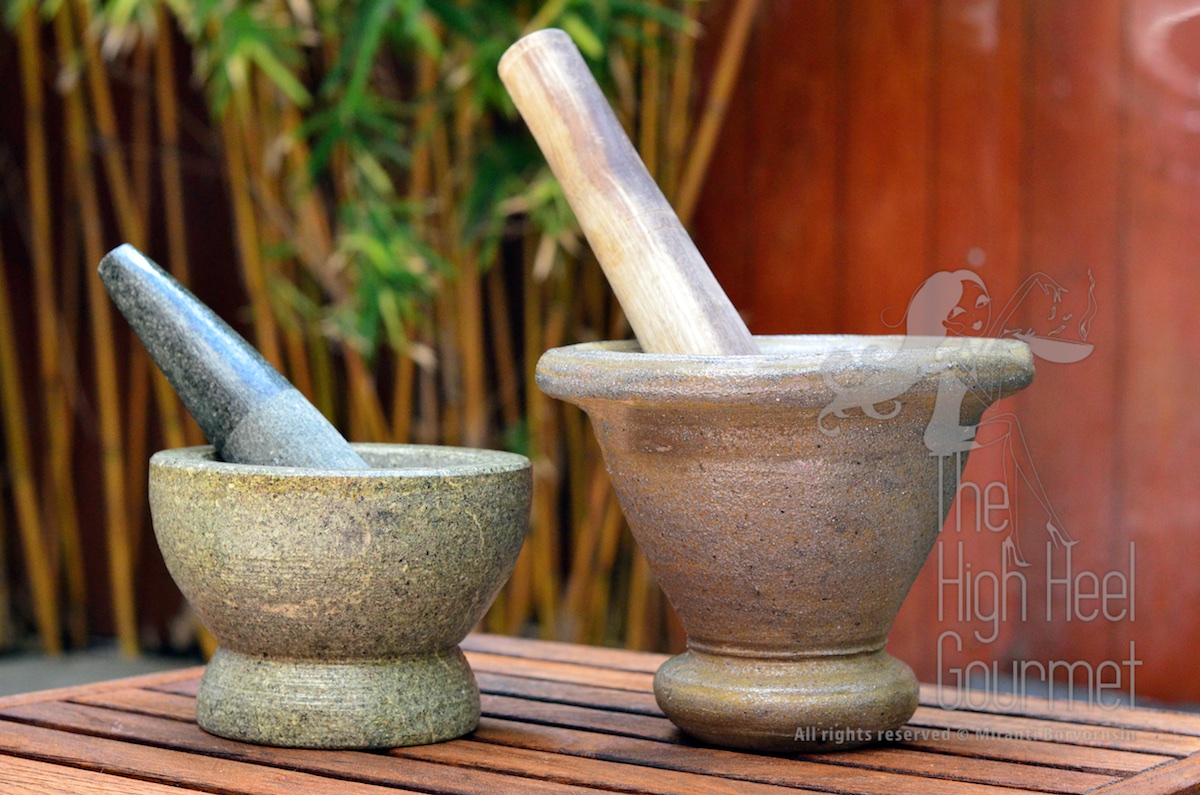
Left: The granite mortar with granite pestle. This is a must-have tool in every common Thai household. Even more so than a rice cooker, because we can cook rice in a regular pot but can’t live without these. Right: The terra cotta mortar with wooden pestle. This is good for making “Som Tam” or papaya salad, NOT for curry paste. The pestle isn’t heavy enough to grind the ingredients, and if you tried to pound them hard enough the mortar will break.
This method is a little more complicated because there is a specific order for putting the ingredients in the mortar. This doesn’t affect the flavor, but just protects your eyes from curry splash and makes the grinding process less painful.
This is the method refined by me. You grind everything listed together unless I say to do it separately.
1) Grind white peppercorns, Coriander seeds and Cumin together, then set aside. If you don’t want to use a mortar, you can use a coffee grinder.
2) Chop the chilies and grind them separately, and set aside. This is the ingredient that could injure you the most, so keep it separate and we will bring it back in at the last step.
3) Now we’re ready to make the paste. Lemongrass is the hardest one to grind so it goes in first with salt, which will help you mush the lemongrass easier. Grind them to a paste.
4) With the lemongrass paste in the mortar, add thinly sliced or chopped Galangal root to the lemongrass and salt mix and grind them all into a paste.
5) Add coriander root, kaffir lime peels and grind to a paste.
6) Add garlic and grind, then add shallots and grind to a paste.
7) Add the pre-ground dry spices together from Step 1 and grind them into the paste.
8) Add shrimp paste and the chili paste that we ground and set aside earlier, mixing them well using the pestle.
There are a few ingredients not previously mentioned that are acceptable in the green curry paste. Here is the list.
Turmeric: This is also another root in the “Zingiberaceae” family but completely different from galangal or ginger. If you’ve been following my blog for a while, you might remember that I used this root in the rib satay recipe (and all satay) and Khao Soi or Chiangmai curry noodles recipe before.
I also used this in Southern yellow curry, Thai barbecue chicken, Gai Yang, Southern style crab curry sauce for the rice noodles, Kanom Jeen Nam Ya Tai, and also Thai chicken biryani, or Khao Mok Gai. The root gives a yellow color. It’s a very common ingredient in any southern curry.
If you make any fish or seafood green curry, you can add this root into your curry paste. Your curry will be less light green (keaw-wan) and slightly yellowish-green.
Mace: Some people use this in their curry, usually with beef.
Nutmeg: Same as Mace. Do you know that Mace and Nutmeg are from the same source? Mace is the membrane surrounding the nutmeg. They smell quite similar but I think the mace aroma is slightly sweeter.
Cinnamon: If you want to use it, use just a pinch. It also goes well with beef curry.
In the next episode I will teach you how to COOK the curry paste and a whole pot of curry.

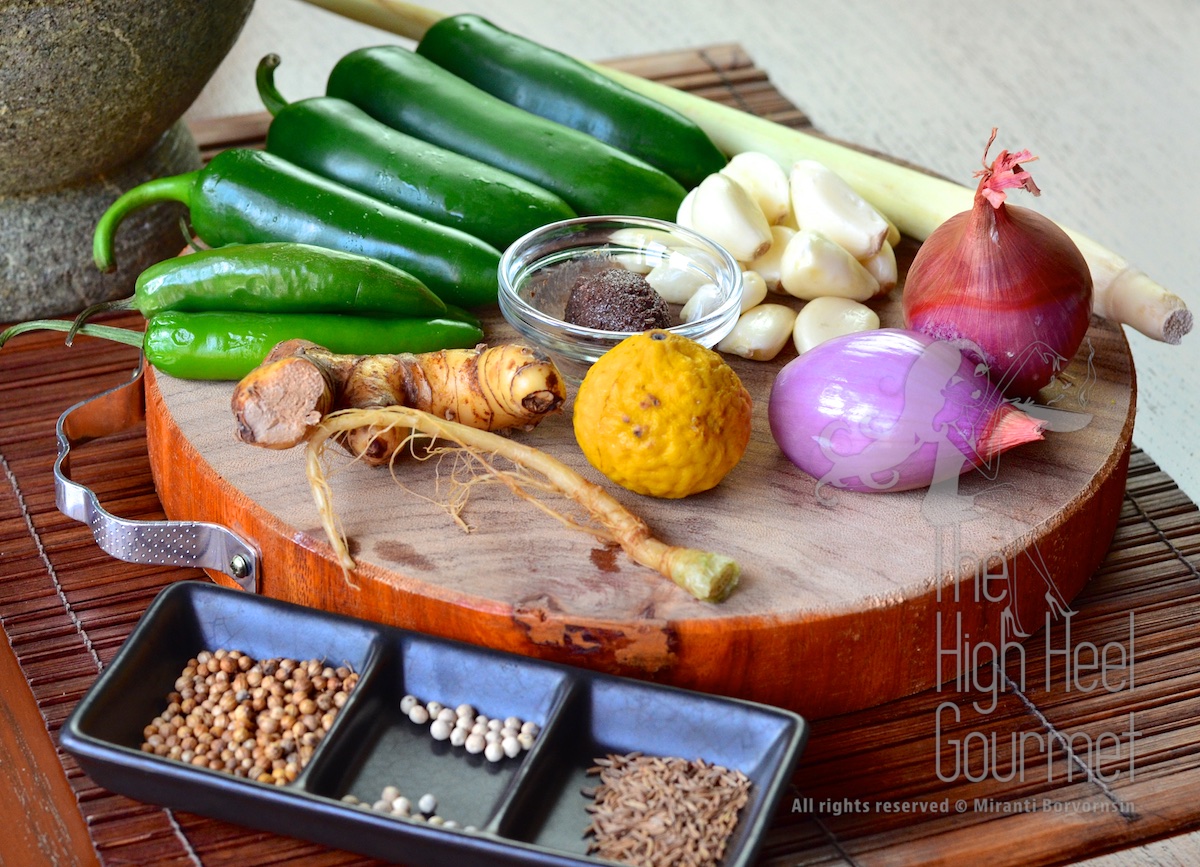
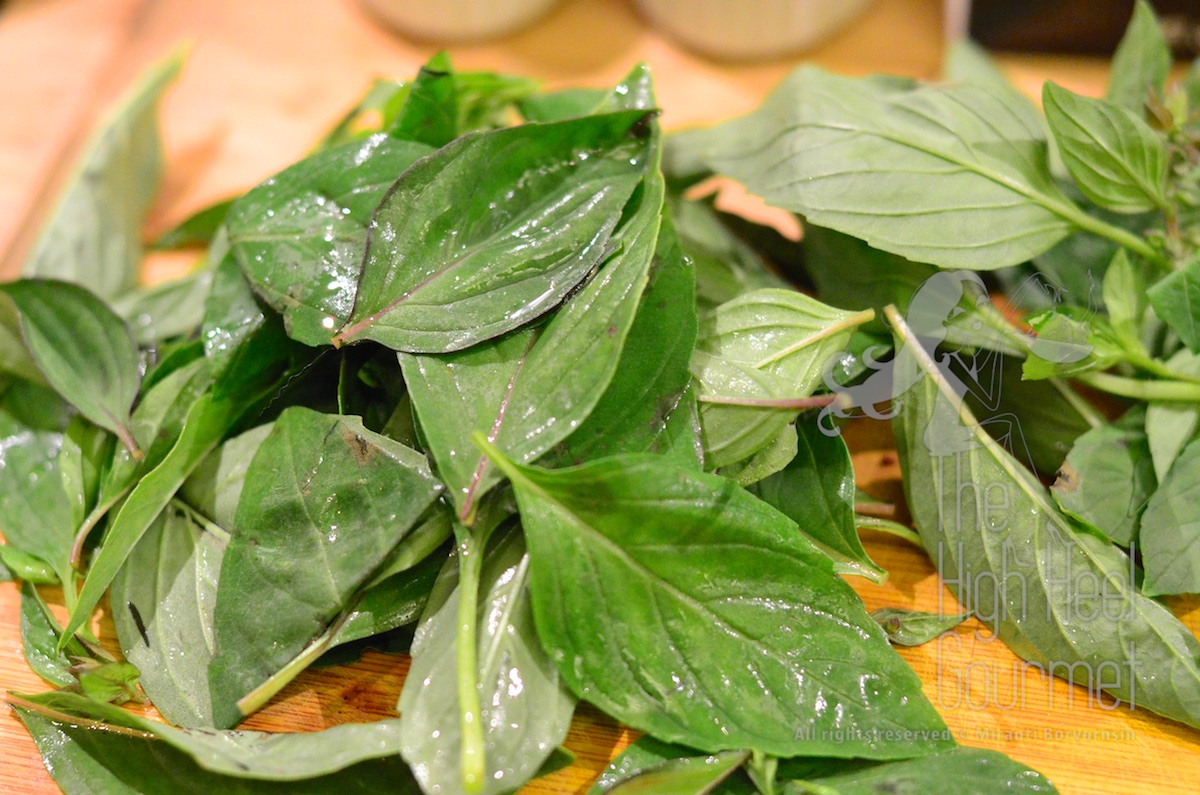
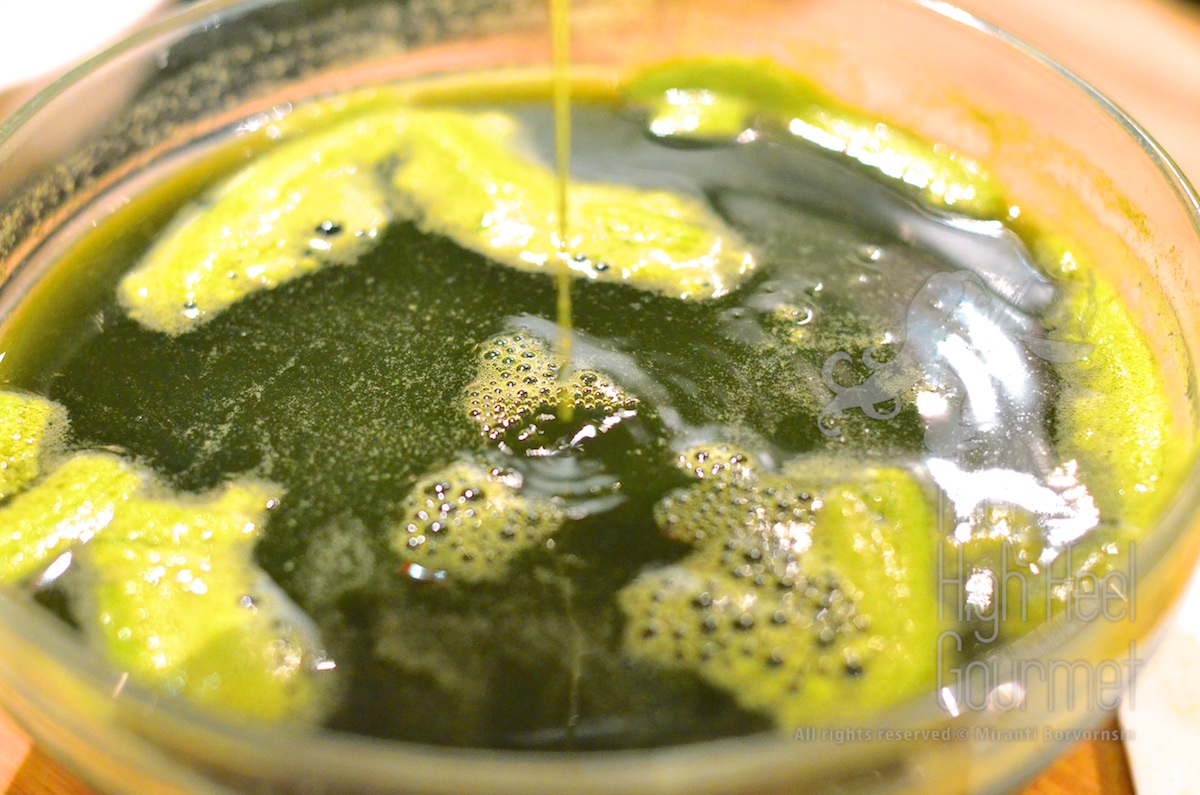
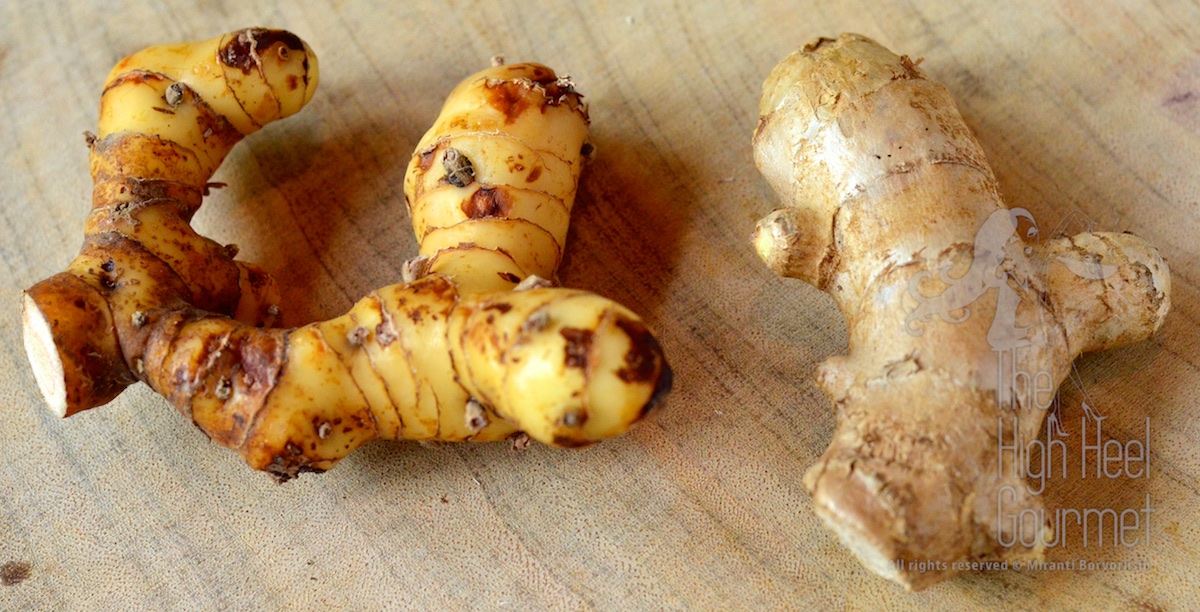
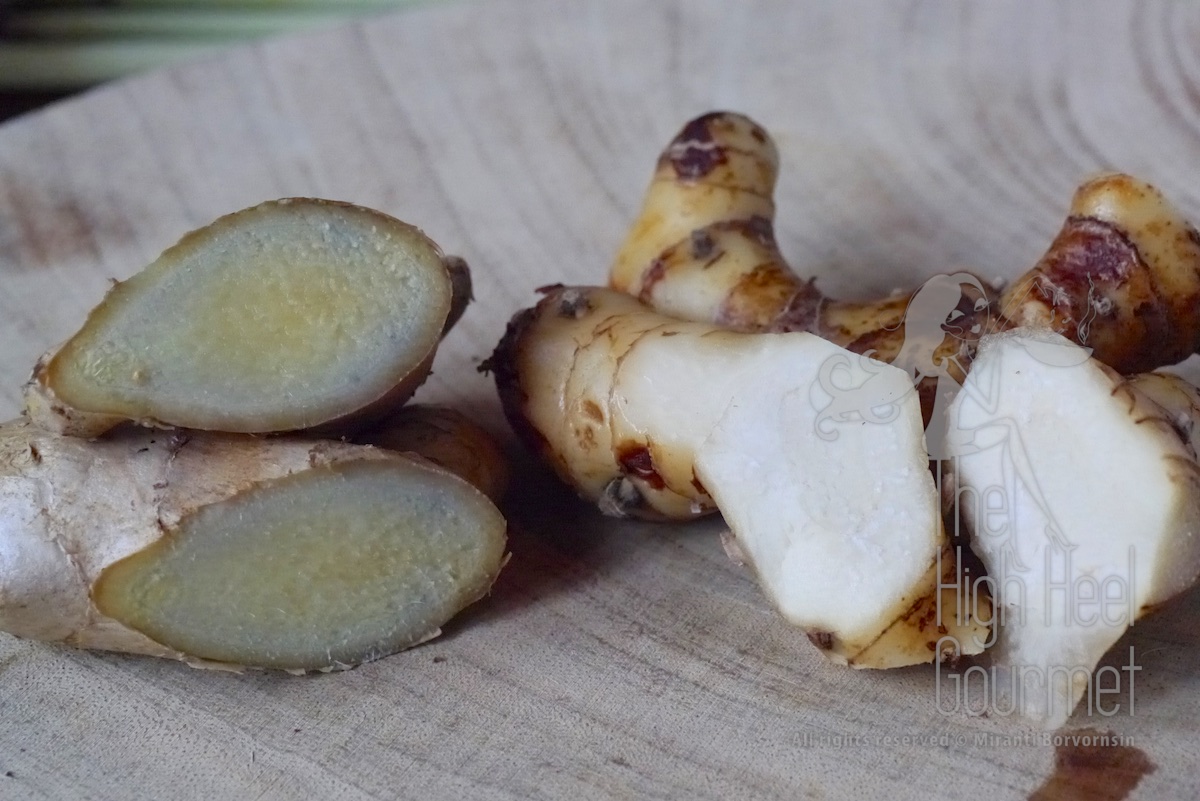
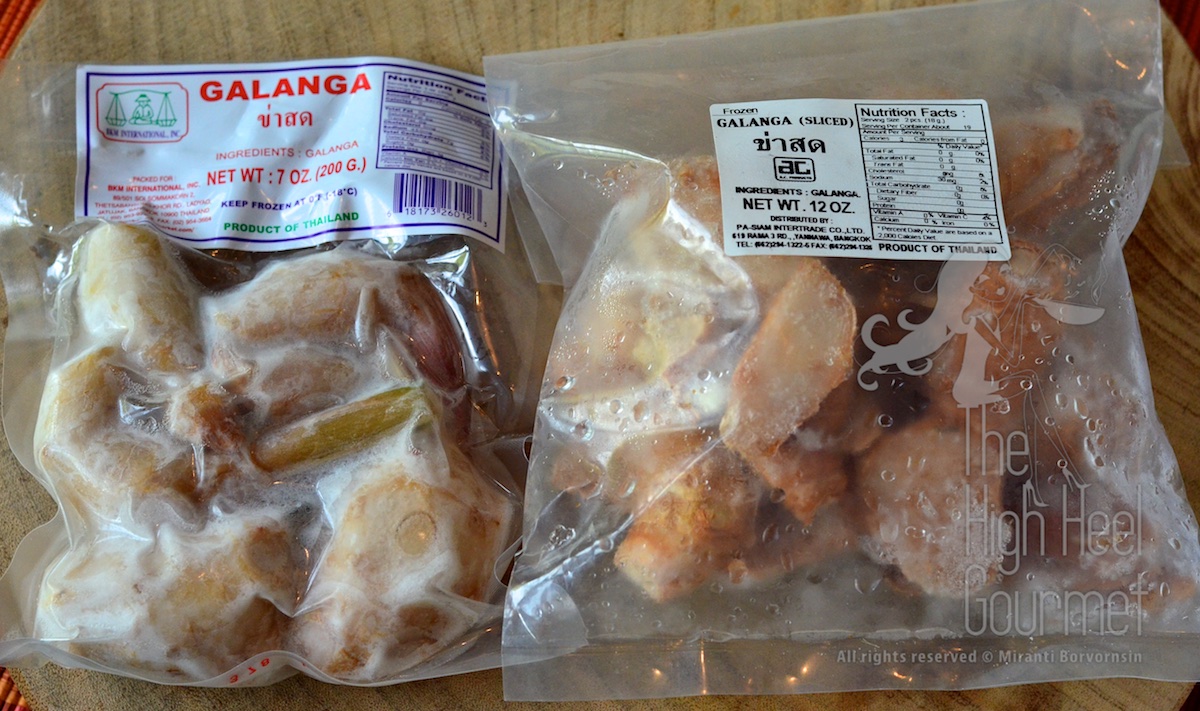
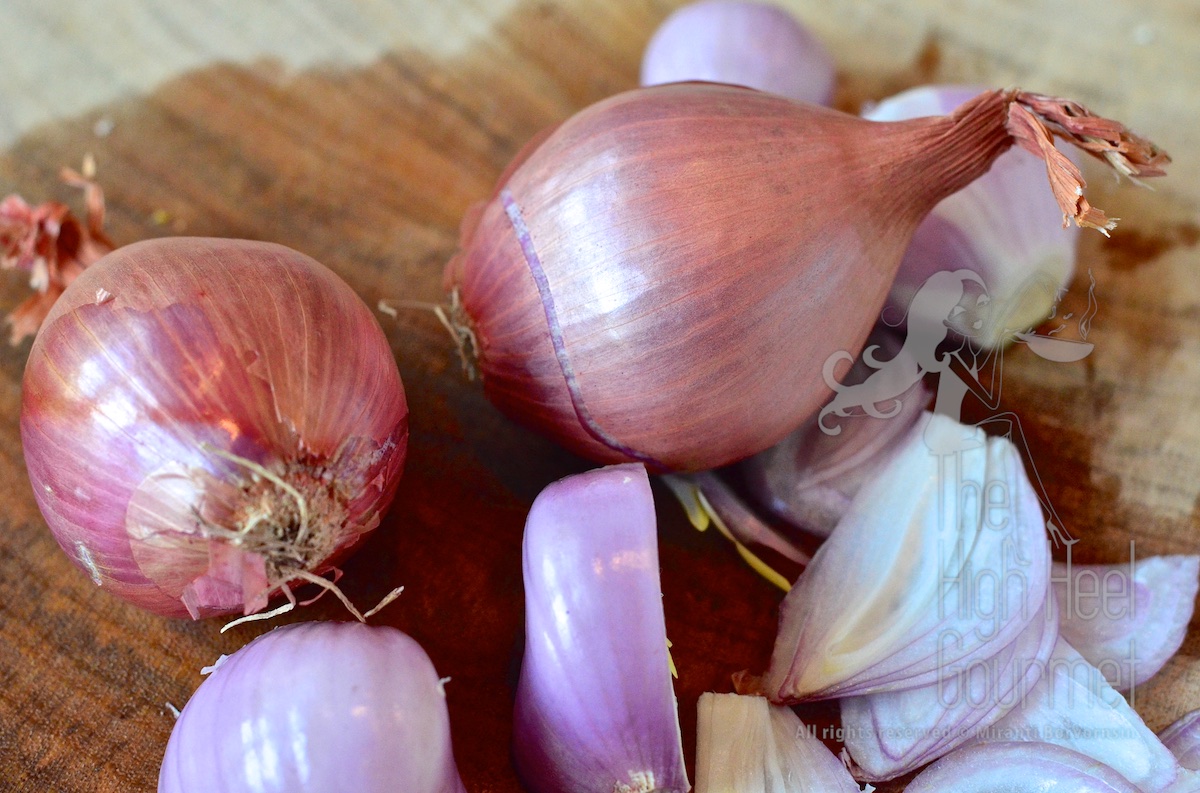
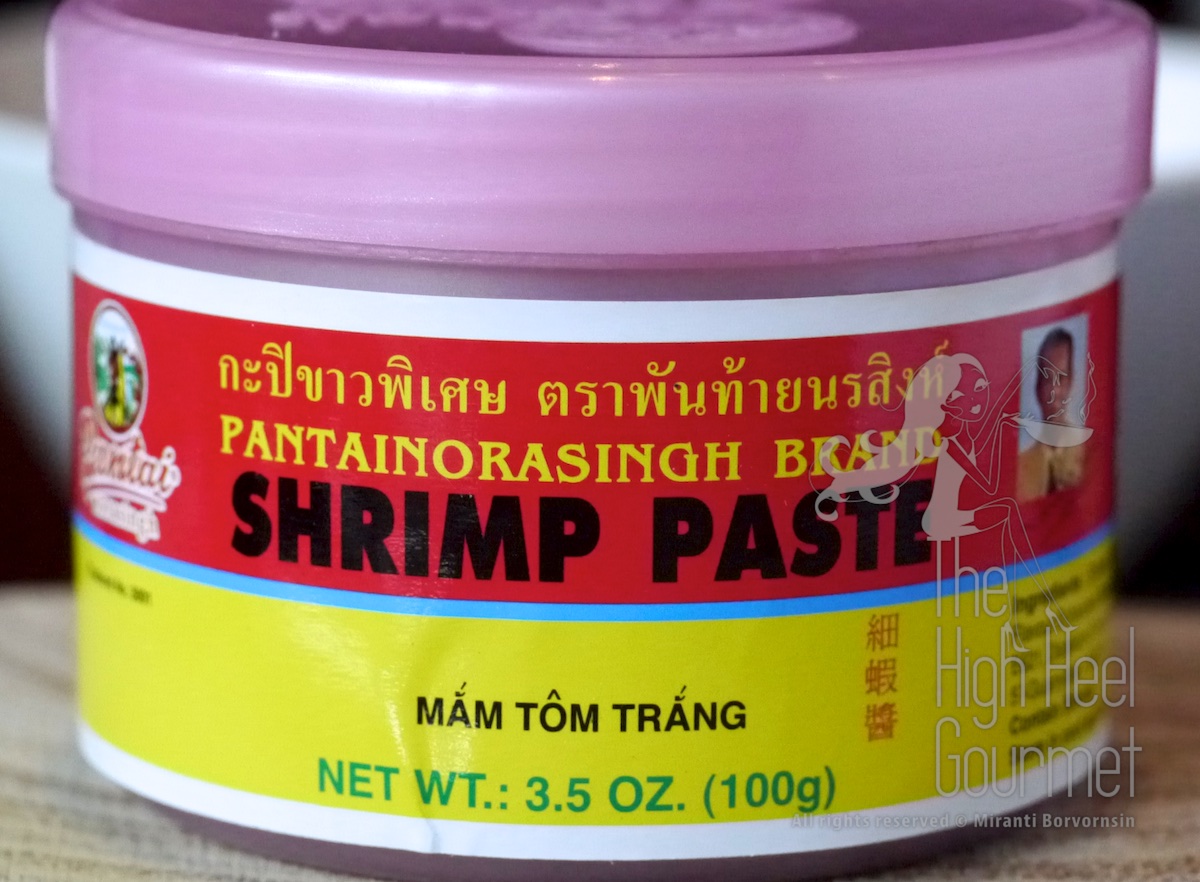
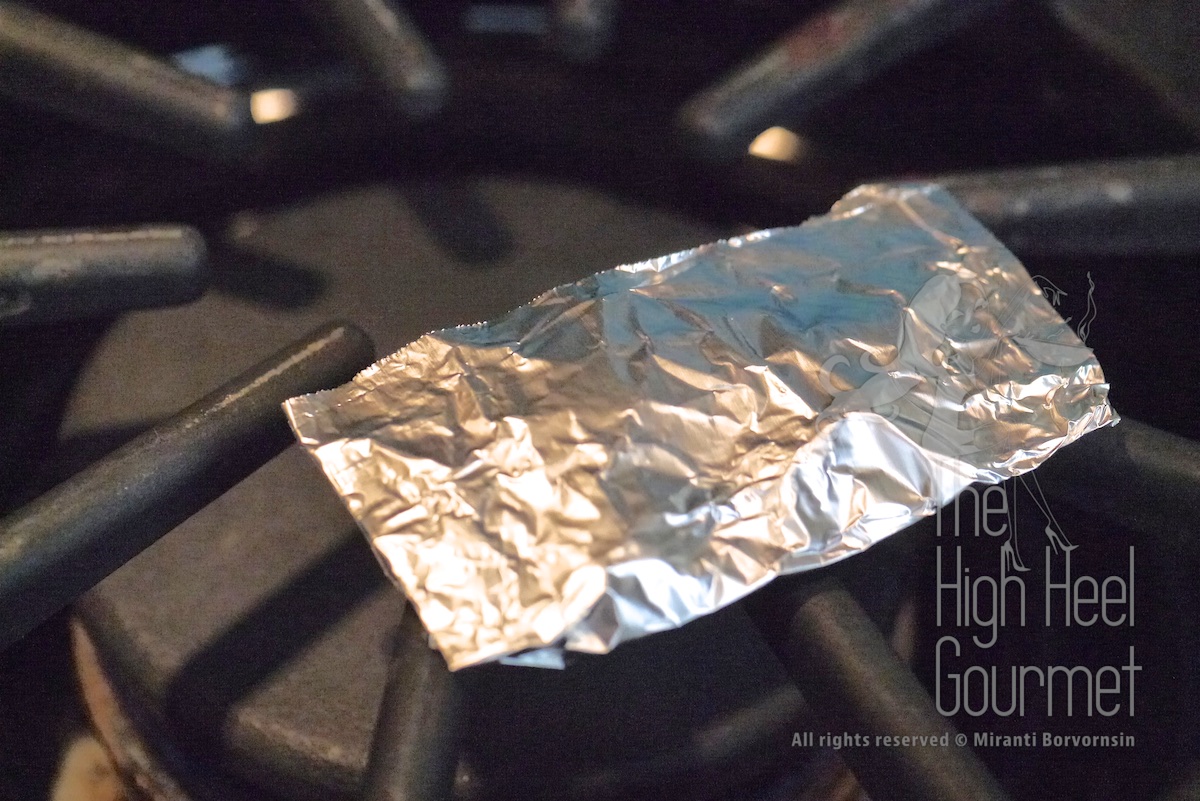
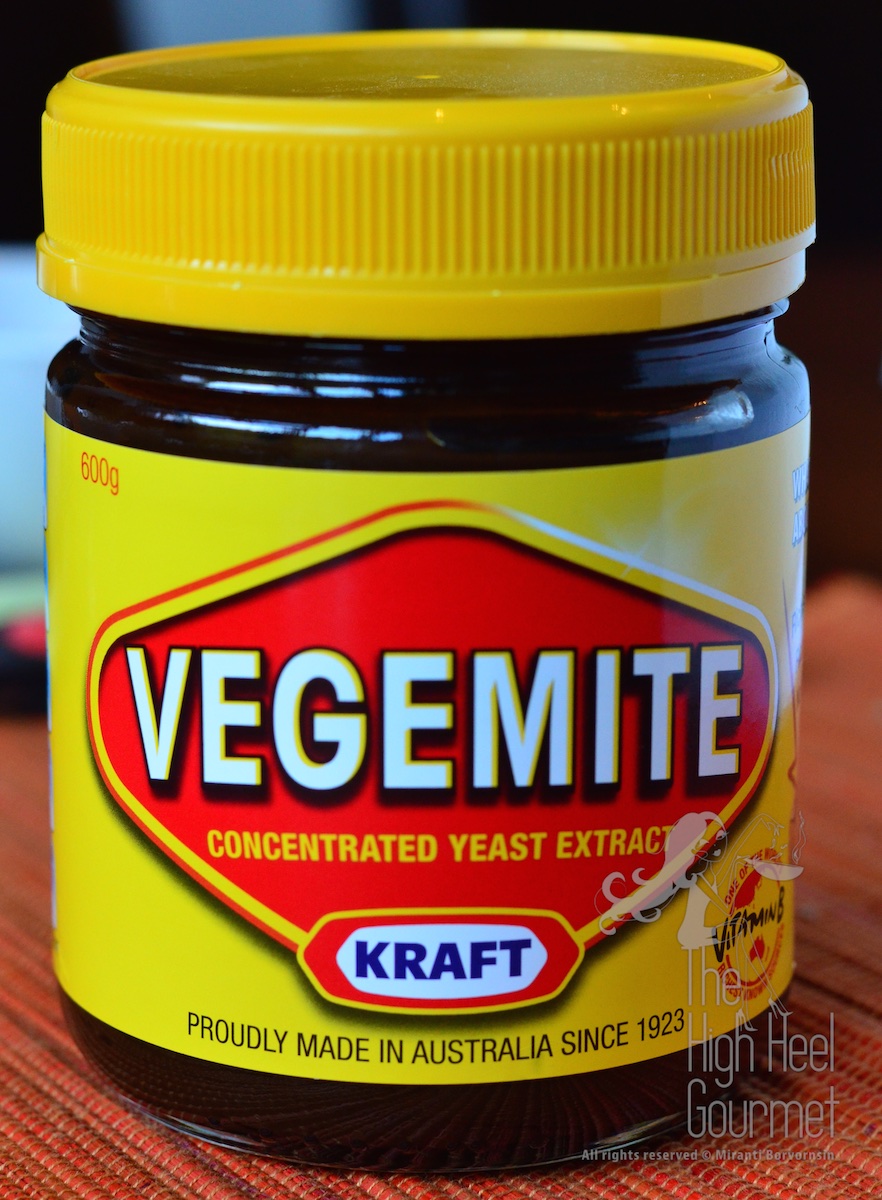
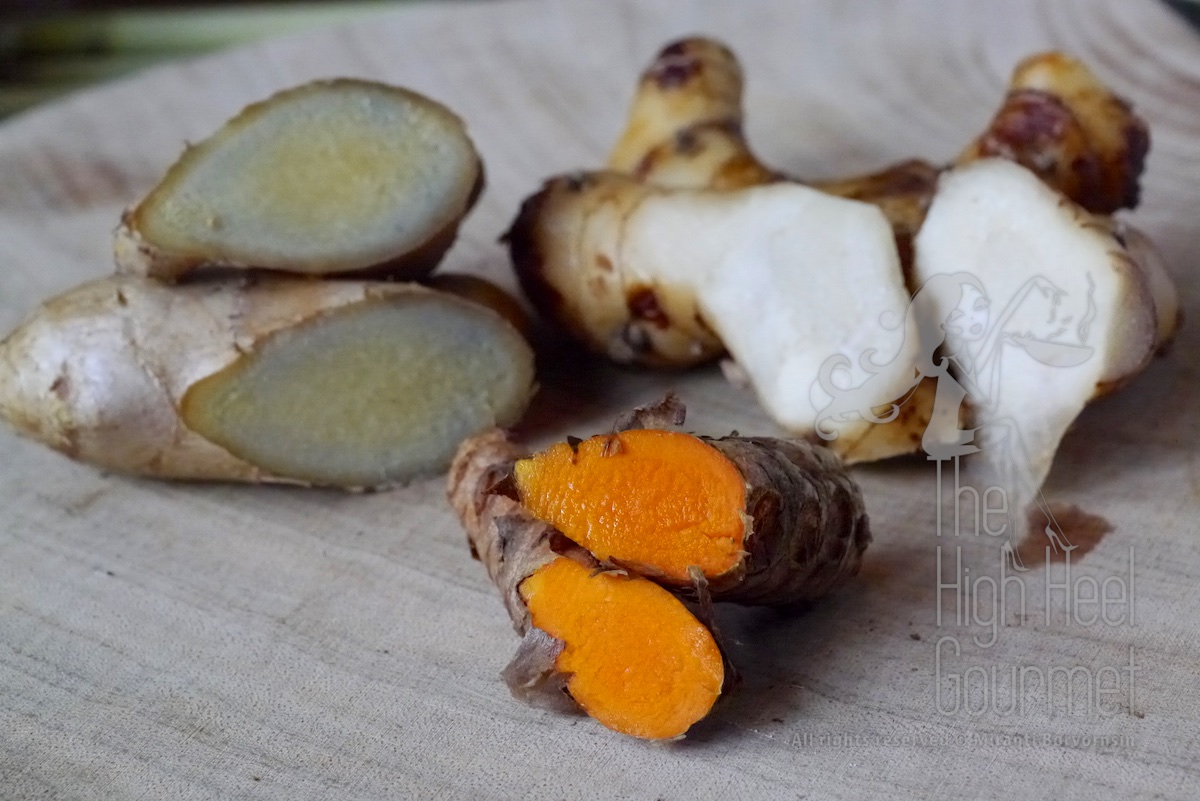
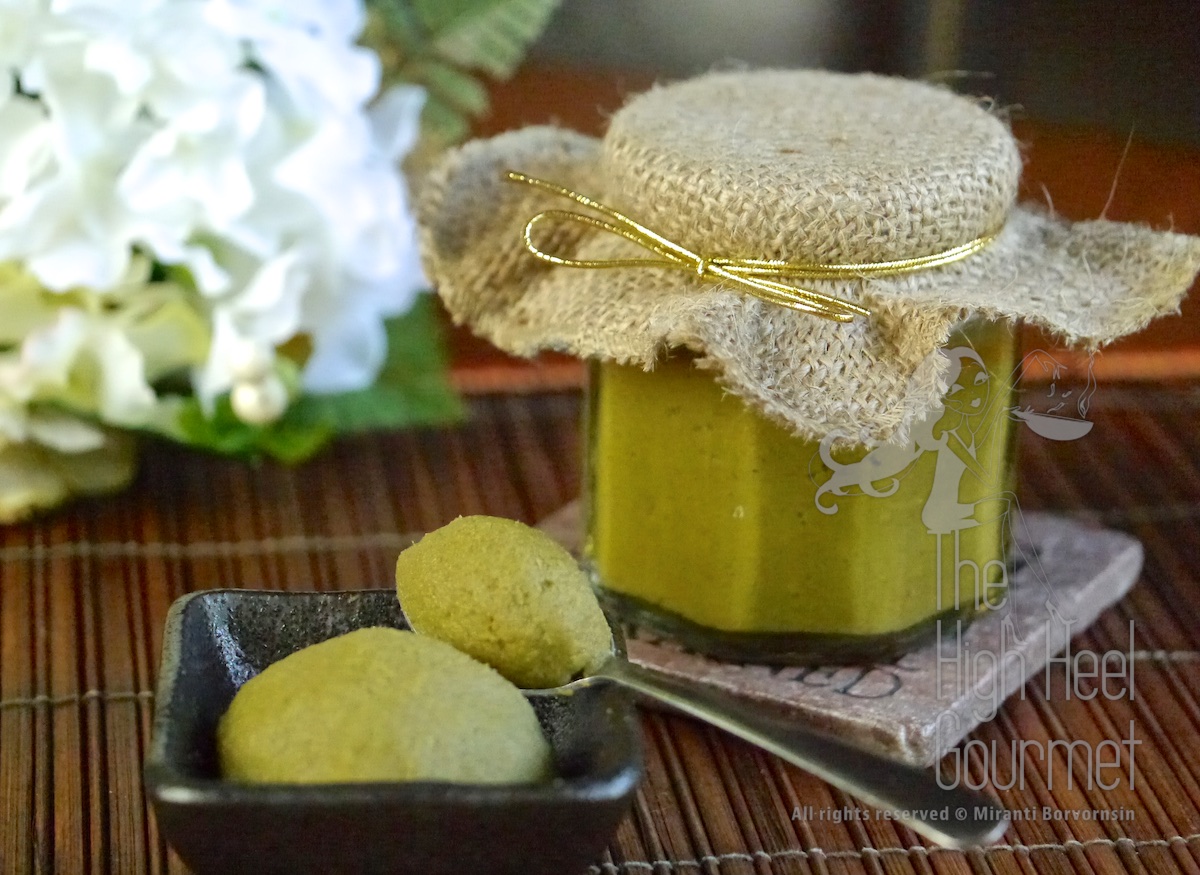
Great colors in your first pic! Thanks for sharing!
Thanks 🙂
I love reading your posts as they make me feel so lucky that all these ingredients are really easy to find here in Melbourne and that the Thai curries I make at home are pretty damn close to being authentic. I’ve picked up some great tips from you so thank you so much for sharing! 🙂
Thanks for visiting my blog 🙂 You’re living in a great city. I saw all the ingredients available at the market and many other items I can’t even get them here in the US. I was just visited Melbourne for the first time in January and had a great time. You can see them from some of my post http://www.highheelgourmet.com/2013/02/28/red-spice-road/ I also went to many others restaurants that my friend, who’s lived there recommended.
Reblogged this on teachkitchenskillsand more and commented:
I would love to learn a bit of Thai cooking
Keep reading my blog you will learn some. I like your blog and your selection of recipes that you post also lots of basic in cooking…Great site! Where do you live? I’m in Manhattan Beach, CA. If you are close by we can do some cooking together and teach each other new tricks.
Thanks for the reblogged.
What a great post. Thanks for taking the time and care to put together such a thorough post.
🙂
Wonderful post– I really learned a lot about all those ingredients– and your colorful pictures are just great! thanks.
You’re welcome 🙂 Thanks for visiting.
Love your blog so detailed. I’ve just returned from a trip to Thailand and have been cooking a lot of Thai at home I’m really looking forward to trying your recipes. I also love all the detail and information you put in your pots
Thanks 🙂 I just want to make sure if people want to make their own Thai curry paste, they at least know what to look for.
This is amazing! I can’t wait to try it! But I may have to search for the ingredients here …
I think Netherlands isn’t that difficult to find the ingredients..no? I was in Amsterdam and the Indonesian store had all the ingredients. If you can find the Indonesian grocery, I think you can find them. The most difficult one still be the Kaffir lime but you can either substitute or don’t use it.
Of course! Why didn’t I think of that 😛 I do adore a good green Thai curry! I’ll try up on the Zeedijk next time I’m up there. Thank you!
The bottled ones make lovely gifts! Thanks for sharing your authentic recipes and introducing the ingredients. The pictures are beautiful. 😀
You’re welcome.
Hi Miranti! Making REAL green tai curry has always been one of things I need to learn to make, I always do it with the pre-made curry pastes. Part of the reason is that I didn’t know some of the ingredients, another reason is that some of the real ingredients are pretty hard to find here where I live. Anyway, I’m following your curry episodes with great attention, they’re great 🙂
Pre-made curry paste isn’t so bad. Now you know all the ingredients and it’s easy to order them online now. Let me know when you made them. You can post the picture on my facebook page https://www.facebook.com/HighHeelGourmet
Hey thats cool I’ll take that into account!
Wow! That looks really hard. Good for you for making instead of buying. Is there a real taste difference?
It’s not that hard if you have the right tools. I don’t like to make then using mortar and pestel because it takes so long and a lot of splash. Once I use the blender or food processor, then making curry paste isn’t that hard.
The taste of the curry by the tongue are not different but the fragrant is quite different between the fresh made paste and the pre-made one. That’s why I made it fresh. (I usually don’t make a lot of curry paste so I can make the fresh one every time.) The fresh ingredients are making the pot of curry smell very pungent and that’s what I’m use to. Most people who didn’t eat the curry growing up, probably don’t detect it.
Very cool. Wish I could be a guest in your home. Sounds delicious!
I love this post and the step by step pictures. Thanks for sharing!
Thanks for checking it out 🙂
“Old and young – like my men.” LOL! Thanks for a lovely, informative post that made me giggle too. 🙂
😉
i love this: so. much. information. 🙂
I know…everything needs explanation! I hope in the next decade I can just say galangal, lemongrass, kaffir lime and majority of people would know what I am talking about…(like they do with ginger and cilantro these days)
galangal is definitely new to me…i’m looking forward to spending a bunch of time at your blog! i am a total nerd so i eat stuff like this up (literally and figuratively)! 🙂
This is great, we are lucky we live near some Thai grocery shops in Sydney, so can find the ingredients (as well as vegemite). more please!
I love Sydney’s Paddy market. I’m sure other markets are wonderful there too. Envy at all your tropical fruits though.
Worth trying some day…:)
🙂
🙂
Great post! One of these days, I will try to make the green curry paste myself using your recipe rather than the pre-prepared ones from the shop. 😉
The pre-prepared one isn’t so bad (except it might be too spicy). I recommend using them if you don’t have time to make the paste. You can still enjoy a pot of curry. If you can find all the ingredients, making your own is another level of appreciation…;)
Reblogged this on ELANA – The Voice of the Future.
Thanks Elana 🙂
Great recipe worth the time to prepare it.Thank you for liking my post. Warm wishes.jalal
Thanks 🙂
Yikes, Vegemite.
lol…wait until you smell the shrimp paste, you will run back to Vegemite so fast.
Reblogged this on Reason & Existenz and commented:
Wow… The High Heel Gourmet tells you pretty much everything you need to know about Thai Curries. Thanks, HHG!
Thanks for reblogged 🙂
surely. 🙂
Thanks for this post and all beautiful photos ! 🙂
🙂
How long can you keep curry paste in the fridge?
Sorry for the late reply…This curry paste can keep for a week to two weeks. If you want to keep it longer cook it gently, such as steam it in the steamer or stir-fried it in the wok over the stove, just to sterile it. Put it in the clean jar and you can keep it up to a month. Just DO NOT freeze it. It smell quite strength after thaw.
Personally, I made it just enough for one pot because I love the fresh curry. It more pungent but I made them for my friends and she kept it for several months (yike) and confirmed that if I steam or stir-fried it first, she can use it up to 3 months.
You had me at the first photo with that beautiful cutting board…♥
hehe…from Ranch 99 market, believe it or not and I can really use it too. You know sometime I found something so cool for photo and it ended up in the pile in my storage box labeled, for photo only, CAN’T BE USED! This one is golden.
Wow! This is an awesome (and very inspiring) post! I look forward to trying this soon. After I gather the correct ingredients of course. I don’t want to get yelled at. ;D
lol…Did you get them? If you have a hard time finding them, order them from online store I gave links. They’re pretty good with shipping fresh stuff.
This is the most detailed post for Green Curry Paste, I’ve ever seen! I love it!! Will use it next time! Thanks 🙂
🙂
What a great combination of colors! Thanks for sharing and thanks for stopping by my blog. http://www.segmation.wordpress.com
I truly think you’re the most meticulous food blogger out there! As always, fantastic work and thank you for sharing!
lol…I always find a way to add drama into simple matters you know. Thanks
BTW I’m still envy at your Truffles experimental and just simply where you live.
Reblogged this on The Narcissistic Anthropologist and commented:
One of the best ways to get to know a culture is through it’s food. Culture, bey definition, is created by our collectiive reaction to our environments and other macroforces. Our environment also dictates our subsistence. From an anthropological perspective, I see the culinary tradition as one way we pay homage to the natural environment that provides us our food – by honoring it with craft and sharing the appreciation of that craft with others. We elevate food from subsistence to celebration when we create things that delight our senses in addition to filling our bellies.
For example, today we are having my wife’s family over for dinner and decided to go with a Cuban theme (for no reason, save that we wanted an excuse to make Mojitos). So, the first thing I did was find the perfect Sofrito recipe.
I just started following the blog that follows: The High Heel Gourmet. I thought my “food-thropologist” readers and freinds would appreciate some really deep instruction on the perfect Thai staple: a green curry paste.
Enjoy!
Thank so much! I really appreciate the reblogging and the comment.
Great ingredients for great food are always benefiting the entire body ~
Agree!
Green Thai curry is definitely my favourite, but unfortunately I can’t eat shrimp paste. Is there any way to substitute it? Thanks for the in depth explanation of all the ingredients by the way, must be frustrating seeing people use things out of context!
Yes, use vegemite or marmite. You can look at the recipe for the green curry paste I posted right before this one. It gives the closet in term of flavors and umami taste.
I got really frustrated with the one that tagging the name “Thai” with their recipes. I wouldn’t might if they said “Thai inspired”. Food culture evolves, I know that but tagging the recipes that Thai people will not eat (just to be polite) or secretly barf out under “Thai” is too much in my opinion.
Thanks for the recipe, I would like to try this sometime but have to say I’m intimidated by the process! I am that person that would try to sub ginger for galangal if I couldn’t find it at the grocery store. Shame!
lol go buy the curry paste…why bother make them of you don’t need to…after you got the curry paste, the rest is easy. On top of that, it doesn’t matter you cook the curry right or wrong, it still come out delicious.
Okay, this is hands down the best Thai Green Paste recipe I have seen! Growing up in Australia, Thai food is second to meat and 3 veg… As a vegan that means Thai food is second to none! I was reading your recipe and felt a little despondent when I got to the shrimp paste, but I kept reading and sooo glad I did! Who knew that I could simply replace shrimp with Vegemite!! What a great idea. Thanks so much and I look forward to cooking with this recipe 🙂
You don’t even know how glad I was when I tasted Vegemite for the first time. It was a eureka moment for me (minus running naked out on the street). I was searching for something vegetarian that can substitute the shrimp paste for ages and failed times after times until I found Vegemite. (The British Marmite is not as good in comparable except the Guinness marmite.) Thanks to the Aussie who keep this wonderful spread going all these years. I brought several jars of them back to the US too.
But I have to admit that I love it best on a plain toast over butter though. BTW I don’t know if you are vegetarian or vegan, Aussie has EXCELLENT organic butter (not easy to surpass the French butter but it’s comparable with just fraction of their price) not to mention at a reasonable price. I wish I can bring them back too.
In Thai cooking you can make most recipe vegetarian easily by replace meat with tofu. I usually tell which tofu is good to substitute the meat with (there are many many different kinds, and the Chinese markets or Asian markets usually have them all). We also solved the shrimp paste in the curry problem, I would say 95% of Thai recipe can be made vegan.
I love the suggestion to use Vegemite/Marmite in place of shrimp paste, but I’ve never seen either in the US. Would nutritional yeast be a reasonable substitute?
I don’t think it’s going to work. Can you show me which one? Most of the one I’ve found in google seem to be powder form. It’s not the yeast but combination of the paste and the most important the umami taste.
Try these website
https://www.simplyoz.com/products/australian_foods/vegemite__groceries__beverages/vegemite__promite__marmite
http://www.worldmarket.com/product/vegemite.do?camp=ppc%3ABing%3Anone%3Avegemite&utm_medium=cpc&utm_source=Bing&utm_campaign=none
http://www.englishteastore.com/vegemite-220g.html
http://www.amazon.com/s/?ie=UTF8&keywords=vegemite&tag=mh0b-20&index=aps&hvadid=1696147857&ref=pd_sl_56hrexu24b_p
Thanks for liking my posts. I really like your posts, they are so expository. Thanks. Good job. Well done.
Love your detail on things like these curries. I remember making my first curry many years ago. I had never smelled anything like shrimp paste in my life, so how could I forget.
I’ll be doing some exploring here. And thanks for visiting….
Haha…I really have a hard time imagining your “shocking reaction” of first time smelling shrimp paste since I grew up dipping a piece of green mango in it and thought it was the best dipping…haha. I have a British girlfriend about the same age. I let her tried my “secret stash” (of course stolen from the kitchen and carefully hid it in my toy container for a special occasion, such as got a stolen green mango from a neighbor’s tree and didn’t want to answer the nanny’s question about the origin of the mango)…guess what…She thought it smell like the rat ate the shrimp paste and left its dropping in place to fool us!…
A good shrimp paste smell soooo good to me (just like the durian smell good to me too haha)
You have a wonderful knowledge of food and science. I love that. And a good recipe for chicken mojo too 😉 I will be dropping in from time to time, keep your wonderful blog going. May be we can trade recipes.
This is like a lesson on Thai curry paste. I never knew such intricate details made the curry taste genuine. I love this post.
Looks great. I’m a vegetarian. Can I substitute the shrimp paste with another ingredient? Thanks.
Vegemite or Marmite
Thanks.
This looks fantastic! I use Vegemite in Italian sauces all the time, but I never thought to use it in Thai dishes. Yum!
REALLY!…HOW HOW HOW…I so love Vegemite and what to learn more about how to make use of it in recipes. Would you mind sharing Vanessa?
Keep up the very good work.
Thanks 🙂
I usually do not comment on cooking blogs but your efforts and humor I find delightful. Your food and explination of history and culture is amazing and your cooking my favorite kind of food.
Namaste
Benjamin
Thanks so much Benjamin 🙂 I’m flattered.
I’ve been meaning to try to make Thai green curry for a while now! I’ll be sure to follow your recipe!! Thanks for sharing
Thank you for sharing such a lovely recipe. I would make it right now but I am all out of shrimp paste 🙁 Love your blog and Thai food 🙂
Hi! This is my 1st comment here so I just wanted to give a quick shout out and tell you
I truly enjoy reading your posts. Can you suggest any other blogs/websites/forums that go
over the same subjects? Many thanks!
You mean Thai green curry or green curry paste? I don’t think there is that many authentic Thai green curry paste recipe out there in English. There are many recipes claimed to be making Thai green curry paste but use cilantro leave, green bell pepper or some even use asparagus. If you see them, those are not authentic (far from it actually, Thai people won’t even think its it green curry). There are a few Thai recipes for Thai green curry. I’ve heard about a Thai lady in San Francisco area who teach Thai cooking class. Her name is Kasma Loha-unchit. Google should know where she is.
Didn’t mean to make a wall of text, but wanted to share my response fully.
Somehow or another I went from finding a way to kick up Ramen noodles to help provide some recipes for my oldest child and daughter who is about to head for college to deciding that my weekend cooking project will be Thai Green Curry using home made paste. After all, that’s what cooking projects for me are all about! This is the recipe I’m going to use.
Please know that I’m fortunate as I am in Northern Virginia and live very close to a Korean supermarket that I go to regularly for nearly a decade, Love the place and produce is usually better priced and fresher than the usual supermarket chains.
It was so refreshing as I usually make Latin food (and they carry a good variety of Latin, American, Indian as well as Asian) to finally realize that most of the items I see all the time, even know where they are located in the store in this recipe. The only thing I am not able to get is the cilantro root and the kaffir lime. The leaves, no problem though I had to laugh as today when I bought them they were incorrectly labeled in English as “Lemongrass Leaves”. But I’ve seen the leaves enough to know they’re Kaffir Lime Leaves. Also not the first time the English part of the label was a bit off or incorrect.
I knew of one market locally that did sell cilantro with root intact, but that stopped about a year ago. I bought it in my, like yours, futile attempts to also grow it. The kaffir lime, I think I may have seen it on occasion at the Asian market, but it’s like fresh figs, a very small window (like a day or so) because it’s so rare, wanted and popular. Now I know why.
I scoped out a few recipes before I left work today and pretty much had the same items as you had, though of course a few variations. So I pretty much bought everything after work tonight in a 20 minute pass through the store.
What I appreciate most in the pre aspect of this cooking project for me was the chili pepper aspect. Of course because of the customer base, there are a great variety of fresh and dried (I know my dried peppers for Latin recipes, especially adobo sauces) but not so good with Asian recipes. I got a few of the Thai peppers, and so glad you elaborated on the heat and why you use jalapenos and serrano instead.
My boyfriend LOVES hot and heat when it comes to food, to the point that if he wants a dish hot, he means toweling off his shaven head because it’s sweaty hot. Me, I had to work up to eating buffalo wings 15 years ago.
I came across some recipes that called for 20 or so of the Thai peppers, and some that said 3. So I of course was confused and I’m a bit too much of a wuss to make the paste and add a pepper, taste, add a pepper, taste….because I fear that I’ll hit a point that the heat will be too hot – added in with my lactose intolerance which would mean cutting the heat with dairy is being cruel to be kind.
So I’m going to go with what I know about chili peppers and go with your guide.
Thank you so much for giving such a great break down of the ingredients and how to use them, Definitely helpful and more so in a manner that you are extending a peice of your own history as well as your families.
Wow…I totally missed this wonderful post! By the time I saw this, you probably a pro of making Thai curry now 😉
I’m really appreciate your effort trying to get all the ingredients. Was it hot? Did you use the mild pepper or you end up using the hot one?
Another trick for your boyfriend, you can chop the hotter chili and add it to his bowl. With the green curry, people do that all the times in Thailand (scary isn’t it…yike). You will get mild curry for your soup and he will get a spicy curry how he likes it.
Sorry again for missing this.
By the way, do not taste the curry paste. It’s doesn’t taste pleasant at all, rather yucky bitter spicy and all the bad taste. You check the balance by sniffing…ha I know, it sounded weird but after making your own curry paste for a while, you will recognize the “balance” smell of your own curry paste.
I never use milk to take the heat away from spice, I hate milk. I use white rice or water or the best is palm sugar.
I’m glad that i make my curry almost exactly as you do. Nearly everything is easy to find in Alberta, even the smaller cities. I do differ on a few things though. I’ll get it out of the way first. When finishing the curry I do add in an onion, but never to the paste. I know I know, but I like what I like, even if it’s an abomination. This isn’t every time though. I also like to put a few Thai basil leaves on top when serving. I love the flavour and even if it’s wrong, it tastes so right.
I also want to say I really like my heat and I don’t use any peppers you do, but instead a bunch of bird’s eye, red or green depending on the type of curry I want to make. Is this not right?
What you do to the chilies are great and not wrong at all. The level of heat is up to you. I like mine mild but most Thai people like it so hot, like you. They even put cut bird eyes chilies in the curry to spice it up.
I have no objection of onion in the curry. Massaman curry also use onion and it is delicious.
Basil leaves, I love them too.
thanks a lot for this great article! You would not imagine how many questions I had about thai curry paste making that this single article has answered…
I have a quick question: in some recipes I have read that garlic is added to the mix with the skin-on. I have also read in indian curry recipes that they keep the skin on for their curries.
Have you ever tried to keep the skin on of the garlic and galangal in your thai curry paste?
Thanks
…i meant that in indian curry recipes they keep the skin on of the **Ginger** when they do indian curry paste… so garlic+ginger
thanks again!!!
The answer is never.
Thai never keep the skin of any roots type herb. I wish we do sometime too, especially with the fingeroot (Krachai) which is the hardest to peel the skin off. We scrape the skin off the cilantro roots too.
It’s for hygiene. We are in Southeast Asia. The soil is full off parasites and bacteria because it is warm all year round so it’s not a good idea to leave the part of herbs that had touch the soil. That simple.
They do leave garlic skin on sometime for the fried garlic, for flavors. Once it is fried, all the parasites and bacteria should be killed, right.
Which Indian curry that use the skin of these roots herbs? Or whose recipe belong too. I’m making Indian curries from time to time but haven’t come across the recipe that require to leave the skin of these roots on yet. I’m curious about the flavor and the taste.
Hi, I think i have found “almost” all ingredients to make my authentic curry paste: galangal, Kaffir lime, … except the coriander root I think I have it all!
I won’t be using the galangal and kaffir lime in other recipes, can they be happily put in the freezer and only be used them when needed?
The same question applies to thai basil, is it also OK to freeze it?
Cheers
The galangal will freeze nicely. You should slice them before freezing or else, you won’t be able to break them apart. If you want to make Tom Kha (http://www.highheelgourmet.com/2012/02/16/tomkha-lobster/) or Tom Yum (http://www.highheelgourmet.com/2013/04/25/tom-yum-goong/) you would need it.
Same goes with Lemongrass.
Kaffir lime is best freeze zest separate from the fruit. You just peel them and put them in in a small jar or bag and freeze them. If you freeze the whole fruit, they will turn dark color.
Kaffir lime leaves also easy to be frozen as well but not the basil leaves unfortunately. You can still freeze the basil leaves by sandwich them in-between paper towel but don’t expect the same result with the fresh leaves.
🙂
Thanks for your helpful reply!
Is there anything to keep in mind when de-freezing the zest, leaves and galangal before cooking them?
Cheers
No, not really. I clean everything and let them dry before freezing (lol…you know why, right) and so they are ready to be used when defrost.
Most of the time I put them in the pot or pan right out of the freezer. Especially with the roots, galangal seems to release juice while ice melting. I am paranoid that I will lose the flavor so, I put them in the pot frozen.
If I use it again for curry paste I have to wait until it soften a bit before I mush them or purée them in the blender. You have to add more if it comes from frozen because it seems to lose the potent of the herbs.
Evеrythinng іs very open with a clear descriptіon of thhe
issuеs. It was definitely informatіve. Your website
is very helpful. Thanks for sharing!
Thanks 🙂
Hi there, I log on to your new stuff on a гewgular basis.
Үour story-telling stylе is awesome, keep doinng what you’re doing!
Woah! I’m really digging the template/theme of this blog.
It’s simple, yet effective. A lot of times it’s very difficult to
get that “perfect balance” between superb usability and
appearance. I must say you’ve done a superb job with this.
Also, the blog loads extremely quick for me on Internet explorer.
Superb Blog!
I’m glad 🙂 I guess years of designing website for a living taught me something useful. Thanks for visiting.
I can’t remember the last time I enjoyed a piece of writing as much as
this one. You have gone beyond my expectations
on this subject as well as I totally agree with your points.
You’ve done well with this.
Excellent beat ! I wish to apprentice while you amend your site,
how can i subscribe for a weblog web site?
The account aided me a appropriate deal. I had been a little bit acquainted
of this your broadcast offered shiny transparent
concept
I tried the mortar version of your recipe on new years eve and its great. But I wonder – at which step do you put in the coriander root?
Yike…sorry about that. I fixed it now. I really forgot about the coriander root and kaffir lime peels completely!
It suppose to be added before garlic and shallots.
The idea of the order is just grind the most difficult ingredients first, the most juicy ingredients last just for the splash control sake because the method is just to pound them together without taking anything out until the end.
In this case the seed spices are the hardest to grind so I instructed to grind them first in dry mortar. The dried chili, lemongrass, galangal are stacked in the order of the level of difficulty to grind. The kaffir lime peel and coriander root are tough but not as tough as lemongrass and galangal and has less juice than garlic and shallot. The fresh chilies are suppose to be ground before the garlic and shallot went in the mortar.
My grandmother method she didn’t remove the chili but I can’t stand it. The splash would hurts my eye, my skin and the area will be sure to swollen even after I wash the splash off. So, I usually use Vitamix or grind them and remove them from the mortar but add them back in at the end.
Thanks so much for asking, so I can put the missing piece back in.
Rally appreciate it 🙂
Dear Gourmet
Thank you for your reply. I figured that you sorted the ingredients by toughness and juice.
I tried this wonderful recipe again yesterday, with my travel companion, we were in Thailand together, it was great. I use a wok and a (self imported) gas stove, and keept the curry there to let it cook.
I think I have to modify the amout of Chilies, because my serrano and jalapeno chilies weren’t spicy at all. So i threw in two more green thai chilies, wich was better, but still mild.
Thank you for your great blog. And keep it that way.
Even though I might not be able to make this paste due to ingredient challenges, it is very nice to know and understand the ingredients and the process used to make it. Thanks!
You are very welcome.
Thank you or liking my recipes sadly I cannot try any of yours as I have not found a vegan one yet. I love you photos. My camera and computer have stopped talking to each other.
There are substitute ingredients listed for vegan too. Such as Vegemite replace shrimp paste in the recipe and you can always use tofu inlace of meat, substitute the fish sauce with soy sauce too. Then you can have delicious Vegan Thai food that is a true vegan.
This recipe sounds great, but I noticed that you use jalapenos and serranos instead of those little Thai Bird chiles. I live near Thai Town in Los Angeles, so I can get all of these ingredients. If I wanted to substitute the Thai chilies, how many should I use for the base recipe?
(Love the mace addition, sounds good to use for beef if I’m not making a panang!)
Are you sure? It is going to be so spicy (I’m scared). If you like it very spicy 6-8 serrano chilies (keep the seeds for heat) for color and 5-10 bird eyes chili for spice is reasonable. You might have to get the chili leave to add color because your curry will be pale very pale green. Normally Thai people will use “Phrik Chee Fah” or chili that is very close to serrano chili to make the paste. I can’t take that much heat so I reduce the amount of serrano and use jalapeño instead.
If you want to use bird eyes chili in the paste 15-25 chilies or 50g should do it (please, don’t invite me to eat that). Also you cut up the bird eyes chillies and put them in the curry itself too. It’s very popular thing they do in Thailand. I never touch it because I saw the chillies but most of my friends LOVE it.
Also this recipe is yield about a cup of curry paste or more. You can cut the recipe in half if you are planning to use mortar. I gave this amount because using the food processor or Vitamix, this is the amount to cover the blade.
Hi, I have preference for the frozen reddish brown galangal imported from Thailand for curry pastes, rather than fresh, because of the more complex flavor that I like. However, recently, I’ve been unable to find it anywhere, instead finding frozen galangal from Vietnam or frozen young galangal from Thailand, neither of which come close to the flavor of the mature imported Thai galangal in my opinion. Fresh is very different. Do you know of an online source (or a physical source in the San Francisco Bay Area) that still supplies the mature root from Thailand? Thanks, like your blog, Matt
I usually go to New May Wah on Clement while I was living in SF. Or try Vietnamese market.
Online try Temple of Thai (http://www.templeofthai.com/food/fresh/galangalroot-8200000115.php). I don’t think you can specify the age of the galangal here but I totally understood your preference. In SoCal we got fresh galangal at Ranch 999 market but they come as they can get. Sometime they are so old you almost can’t cut them with knife. Sometime they come so young and still smell quite citrusy and with faint smell of galangal.
If I’ve got the young one and I want to make curry paste, I just use more of them. If I’ve got the old one and I want to make Tom Kha, I just slice them very thin and use less of them.
Thanks, I can check out New May Wah. We’ve got sources of fresh galangal all over San Francisco, but I’ve been told (and my less sophisticated palate agrees) that the locally grown galangal is more spicy but less complex in flavor than the Thai-grown root, which is why I had been using frozen Thai galangal preferentially over fresh American-grown galangal for curry pastes. Do you typically prefer fresh local galangal (if the appropriate age) for your curry pastes?
You are absolutely right Matt. I salute to your sense of smell. I know it because I spent a lifetime around them but you can detected and identified them too with out that practice. Do you know that most Thai people don’t realize the different?
I still prefer the fresh one over the frozen. I do used the frozen one mixed with the fresh one because the taste of the frozen galangal is slightly bitter. So I substitute some of the fresh with a few slice of frozen to get the earthy almost smoky smell that I’m use to and want those to cut down the citrusy smell of the locally grown one. The spicy part of the fresh galangal won’t effect the curry paste as much because the chili would over power that quite easily.
I’m honored 🙂 So that then is the question; I can’t find the nice earthly smoky frozen Thai root anymore even though I had been able to find it for years, now only the frozen Thai young root, or frozen Vietnamese root, neither of which are giving me that flavor. Are you able to find frozen mature Thai galangal these days? Thanks again, Matt
Nope, but wait until falls and check the frozen section again. It is a rainy season again in Thailand. Right after the summer. There are plenty of young root right now and they will get older over the rainy season. I hope by November – December I can get some too. I bought mine last December and still have some left but they would be gone by July or August too.
Thanks for the tip!
Hello.
I cant seem to find fresh jalapeño or serrano chillies. Would it be ok to substitute for other green chillies?? Any suggestions?
Thanks
Any green chili would be ok. I picked the Serrano or jalapeño because they’re abundance in my area and I know how spicy they are. Just don’t use green bell pepper, you should be ok. In Thailand they use bird’ eyes chili and cayenne pepper.
Hi, I would like to check if the Malaysian shrimp paste called the “belacan” can be used in place of the Thai shrimp paste?
You can but you have to roast it a little longer because it’s quite wet. So roast it at a lower temperature because it might burn.
This one looks interesting. I’ll give this a try this coming weekend and I’ll let you know how this one turned out!
This recipe is absolutely awesome!! I’ve made this twice now when I can find the time- though when low on time I also love rawspicebar’s thai green curry paste as it’s freshly ground and prepared and as authentic as any green thai curry I’ve had. I’ve purchased it here: http://www.rawspicebar.com
Nice post. I learn something new and challenging on sites
I stumbleupon on a daily basis. It’s always interesting to read content
from other authors and use a little something from their
web sites.
Amazing blog! Do you have any tips for aspiring writers?
I’m planning to start my own website soon but I’m a little lost on everything.
Would you advise starting with a free platform like WordPress or go for a paid option? There
are so many options out there that I’m completely overwhelmed ..
Any suggestions? Thanks a lot!
Hey Miranti, I’ve been noticing that many of the comments you are getting on your blog recently are actually spam comments. I have a blog also and it took me a while to realize this, but scroll through your comments and look at the ones that don’t actually mention Thai cooking or anything specific, and then look at the sender; you’ll see actually links to commercial sites that frequently have nothing to do with cooking or Thai culture. They are just robots trolling blogs to get comments on them that include links back to them, to increase their ranking in searches if they show up on your website. For example, your recent comment that read “Nice post. I learn something new and challenging on sites I stumbleupon on a daily basis. It’s always interesting to read content from other authors and use a little something from their web sites.” I suggest that you turn on comment moderation and don’t approve any comment that isn’t relevant to the topic, especially if they are from sources like “Best Blu Ray Players” or the ones from Aug 19 and Sept 6, because they’ve been piling onto your blog recently. Cheers, Matt
See it happened again, with the spam comments unrelated to Thai cooking. All of these m88 comments are showing up with different commercial links if you hold the cursor over the “m88.” The problem is, everyone who is subscribing to get comment updates on the posts are also getting these e-mails, so if you enable comment moderation, you’ll be doing all of your subscribers a favor 🙂
Can you please, tell me how to do it? I’m not on my computer for a whole since I’m on the trip but willing to learn the trick…thanks so much for telling me.
Hi, I am glad to find your blog because I want to try making real Thai green curry. I’m thinking to buy the mortar & Pestle from ImportFood Thai. Is a 6″diameter (1.5cup) good enough or should I go for 7″ diameter (2cup)? My family is small, just 4.
Really thankful if you can help me out.
B
The diameters are from inner edge or the outer edge of the mortars? Check the weight too. Stone or granite mortar are so heavy. Buy the biggest one you can carry. I would love to have the bigger one but I might not be able to move it and might end up with the small one.
DO NOT use the terra cotta mortar wooden pestle making curry paste. You would have to pick between a corse paste or a broken mortar.
The measurement is for inner edge and is a granite mortar.
I measure mine. It’s only 5.5″ for my big one and 5″ for my small one. So, 6″ should be good enough. The thicker the granite is, the better and long lasting.
Thanks for the help!
OMG What a long, detailed and very beautifully explained post! I am from India, but I love the green curry paste in certain thai restaurants. I have found some to be very watery, and some to very creamy as a result of the coconut milk. is this an everyday dish in your country or is it reserved for special occasions? Also does thai cooking have a version called “Cashew Curry”? I am going to try to get all these ingredients but I am really having second thoughts on Cilantro Root! I have never seen THAT as an ingredient in any curry! Also I don’t eat meat, so I am going to skip on the shrimp paste. I have also seen people making a dry chutney sort of a base and then diluting it with the coconut milk for serving it. I am super confused.
Shobha
This is an everyday dish not any special occassion dish at all.
For the Cashew curry, I am not sure if we do have them. We do have a Panang curry (http://www.highheelgourmet.com/2013/09/29/authentic-thai-panang-curry/) that uses peanuts in the curry paste and Massaman curry (http://www.highheelgourmet.com/2013/11/23/authentic-massaman-curry-paste/) that put either peanuts or cashew nuts in the curry. These two curries also maintain the obvious influence from the Indian curry.
Cilantro root is a part of basic Thai flavors. A lot of my indian friends can detect this spice right away. They said its obviously strength smell to them even though they can’t identify what it is. You cannuse the stemnif cilantro, if you want to make it authentic, you should use it but skip it is still ok.
If you are a vegetarian, please, just don’t just omit the shrimp paste. Try your best to use Vegemite or Marmite to replace the shrimp paste. (If you can’t find it, contact me again. I can search and provide you a link to buy online but it’s mormally available in many groceries.) It would add the flavor and umami taste that set the Thai curry differently than others.
I don’t know about people making chutney and diluteing with coconut milk, ewwwwww…sounded gross actually.
Hi. I´m ready to try this, but I want to make the paste in advance and store it in a jar. You say you cook the paste? How and how long before you put it in the jar?
If you want to use it in the same week, no need to cook it at all. You can store the finished curry paste in the fridge. In fact you might be able to store it up to a month, if you don’t add water or coconut milk.
If you want to store it outside the fridge, then you just cook it enough to sterile the paste. I stir fried the paste with coconut oil over medium heat until I see the steam come out of the paste. It took about a minute or two think (sorry, I haven’t done it in a while). Then you have to bake the jar or boil the jar and boil the seal jar again after pack the curry in it.
Salt is a good preservative. If you add more salt, it would help.
Hi
Fantastic post. Very clear. Thank you. Question: what about kafir lime leaf in this recipe??
And also, Jamie Oliver perverts the recipe by using spring onions (can’t remember what they call the, in the USA – sorry!). What are your thoughts on these two things?
Many thanks,
Ilan
Kafir lime leave in this recipe? I’m or sure if I understand the question correctly. Kafir lime leave can be torn and put in the curry, yes. If that’s not the right guess please, ask again.
Spring onion is just wrong in all curries. If you see spring onion in Thai curries anywhere, don’t eat.
High Heel Gourmet, thank you very much for the amazing recipes and very helpful ingredients advice.
Your explanation about why not to freeze curry paste has answered a question I hadn’t even thought of asking, why my Thai curry tastes so good when I make it fresh, but really loses it’s edge when I try the same dish with the same paste (having frozen it previously).
I’m now stuck with many (home made) frozen red and green curry pastes and it could be a month before I can get all the ingredients to make fresh pastes again.
Do you have any suggestions for using the frozen pastes?
Maybe a suggestion for how to still get the best out of the paste to make a curry (fry paste before using?) or maybe use in a broth/soup type dish?
What’s your opinion (or advice) about cooking up a large batch of red or green curry, then freezing individual portions, I’m a live-in carer, so don’t have as much freedom to cook as I would like.
Thanks again, I’m off to look at many more of your pages.
If I have old curry paste, i would make pizza sauce with it.
You stir-fry the curry paste with coconut milk or coconut oil with coconut milk until fragrant. Put chicken piece in to stir fry too.
Spread the cooked paste on the pizza, add the cooked chicken and vegetables then the cheese. Bake until cook.
My curry paste is getting better… I did it so many times than now I am able to prepare it way faster than before 🙂
I freeze the ingredients I rarely have in my fridge, which I only use for curry pastes: galangal, lemongrass and coriander root (yes, I managed to get some by asking in all the asian supermarkets in dublin ha!). So, i don’t need so much shopping preparation as before
Is it OK to also freeze thai green chillies, and sweet basil? Or would these 2 ingredients lose the freshness so important in green curries?
Thanks!!!
No, green chili and sweet basil are not freezable. The basil will wilt and the fragrant will be destroyed. The green chili will also lose both fragrant and potency.
There was part of this thread some time ago where I saw a response to you saying that curry paste can’t be frozen, but I couldn’t find your original mention of that. Could you repeat it here? Many Thai cookbooks say it can be frozen indefinitely. I’m curious about the reason you have that it can’t. Thanks!
If you freeze the curry paste, when you thaw, you lose the flavors and some of the ingredients might turn even more bitter. My point is, you spent these time to make fresh curry paste, why freeze it to make it lesser potent than the pre-made one. To me, I rather make small amount, so I can have fresh made one to cook. That’s what the Thais would treasure. The one that said you can freeze them, are they Thai? Would they freeze their own curry paste? It’s just the cultural approach. We just love fresh, potent curry paste.
Thanks, I actually tried to reply the last time but the website wasn’t accepting replies at the time for some reason. Now it seems to be working. The person who suggested freezing it actually is Thai and teaches a Thai cooking class, but I’ve spoken with her and her husband since, and they don’t actually freeze batches of curry paste themselves, saying it would be of lesser quality than the fresh batch; they basically just said that you can freeze the rest of the curry paste if you want to. There are other cookbooks out there that say that you can freeze it indefinitely, but those are not Thai people I think. I have noticed myself that when I make a double batch and freeze the rest of it away, it doesn’t taste bad, but it lacks some of the vibrancy that the original batch had.
The way I do it. I add a little more salt to help kill the bacteria and store it in the fridge, same as the merchant that make the pre-made curry paste in the market in Thailand. This way you do t get the bitter taste and the flavor is slightly better.
Yes, I had noticed that, although I was a bit surprised because given the care that presumably goes into hitting the right balance of salt with the other flavors, adding more salt and especially an undefined amount of extra salt sounds scary to me!
Practice it…the more you do thing without strictly measure, the closer you are to the Thai. Nothing wrong, when you cook the curry, you taste it before you add fish sauce. No big deal. (Much less than make fresh curry paste then freeze it to ruin the taste of your curry by multiple levels.)
Makes sense, thanks! Any idea how long it stays good with normal salt, and about how much extra salt is required to extend the fridge life?
Two weeks with normal salt (or longer depend on your fridge temperature and where you place the jar).
Twice more salt isn’t going to hurt the curry. I actually don’t know exactly but I’ve been told by the cook at my house that “store bought curry pastes are salty, taste your curry before you season.” So, I did a d ended up using half amount of salt in my curry if I used the store bought. That’s how I gauged it.
thank you!
There is a response in this thread to you saying why curry paste can’t be frozen, but I couldn’t find your original mention of that. Could you repeat it here? Many Thai cookbooks say it can be frozen indefinitely, so I’m curious about the reason you have that it shouldn’t be frozen. Thanks!
Are those cookbooks were written by the Thais? I guess not. Freezing curry paste isn’t in our culture. If we want to keep the curry paste, we would add more salt to preserve and put it in the refrigerator but NEVER freeze.
Freezing the paste causes the water content to be frozen and will leak out when thaw. The paste will lose its potent and increase the bitterness in the paste too.
The reason that we make our own fresh curry paste is to maximize the freshness and the flavored if the ingredients. If we do not care about the freshness, there are a lot of pre-made curry paste selling everywhere in the world. Why even bother make the best curry paste and ruin it to the point of lower quality than the pre-made by the freezing process.
This was very tasty even without the cilantro roots. We like things spicy so I substituted 8 green thai chili peppers for each jalapeno. It ended up being about the same as ordering the highest spice level at the restaurant. What does roasting the shrimp paste do? I forgot to roast mine! Just wondering how it will change the taste…
Roasting the shrimp paste is normally to eliminate the funky smell and cook the shrimps paste. Once the shrimp paste is cooked, it releases the umami smell and make the paste smell more complex. If you forgot, it’s ok. It’s not going to kill the curry paste.
Salute to the real Thai, you. You can take way more spice than me!
Thanks for the explanation – I will remember to roast it next time!
I have tried finding coriander roots in every single Asian shop in Dublin ha!
I could only buy it once, in a Chinese shop, when I saw then cutting and preparing the coriander in bunches for sale… And I asked them to keep the roots in my bunch 🙂 I wasn’t successful asking to reserve the roots for me in the future …
My next attempt is going to be buying it frozen. What is the commercial brand of your frozen coriander root pic?
Thanks!!!
Can’t you buy the whole coriander and cut the roots? Are they come with the roots or not? I’m so surprise that in Switzerlamd the camp me with the roots. I’m very happy 🙂
Unfortunately, in every single shop I tried the coriander comes without the roots. I could only buy it once with roots , because I saw that in the back of the shop they were cutting the roots to prepare the coriander for sale…
I tried again and again to convince them to keep the roots for me… But apparently I am not too convincing 🙂
so, I am giving up the fresh coriander root quest…
Come to Switzerland…I will keep some for you 😉
Can you fine a Thai market? Well may be next year after I launch my business here, I will go check it over there just to see how can I find it.
I am not sure if this is the case with everybody , but when I prepare a green curry paste, I just cook green curries for a week until the curry paste is gone 🙂
something that could be useful (for people like me) is to know what else you can do with the curry paste. Basically, a list of recipes to use the curry paste
Just a humble suggestion. Your site and recipes are amazing
Have a nice weekend!
Authentic Thai green curry paste is quite specific and we don’t use it any other way. (You probably frown right now) BUT I’m a recipe developer, remember 😉. I do crazy things. Here the list.
– substitute the Kang Kua curry past in the steam fish cake (Hor Mok) with green curry paste.
– stir fry with calamari and regular eggplant in oil.
– stir fry with steam rice and chicken (sorry no recipe yet) but stir fry in oil until fragrant, add chicken, add COLD steamed rice, season with fish sauce, sugar, garnish with basil. You can also add fresh green or red chili too.
– stir fry the same way as the fried rice but use the pasta and meatballs.
– add the already stir-fried curry paste with oil to the boring chicken pot pie filling
Etc.
I’m sure you can go on with this list on your own free imagination. 😊 They are not authentic but delicious and you might be surprise to see the dish you though you had created was served at a restaurant in Thailand. The world of Thai cooking has no boundary. If it tastes good, it’s good to go. Enjoy!
Thanks . I will free up my imagination 🙂
I regularly use a tsp or so in egg salads 🙂
How many eggs you use with that teaspoon of curry paste? Interesting…I never done this before.
Hi Miranti,
Hope all is going great with you in Switzerland!
I am back with more questions 🙂
As you said a few times, It is very difficult to control the strength of every ingredient that goes to the paste. But how do you taste for balance if you are blending everything together? Do yo use your nose? Or by tasting a tiny bit of the paste?
For example, I know keep small bags in the freezer with the ingredients I need for an individual curry paste that are OK to freeze and more difficult to find in supermarkets. Each bag contains lemongrass, kaffir zest, galangal and coriander root.
I did one paste this week and I felt that the green chillies were more protagonist this time, and the lemongrass and galangal were way less strong. Frozen ingredients have less smell and probably lose taste too?
Thanks
Yes, Mixy you use your nose and from recognized the less pungent of the frozen stuff, you had graduate from the beginner class to the intermediate one 😊. That reason is why I want to keep all the ingredients frozen separately because it is much easier to fix by smell the balance while you mix the paste. You might have to add more lemongrass, if you use the frozen in this case. But if you freeze the whole paste, each ingredient react to the frozen stage differently. That make it harder to adjust the balance. Plus you can mix the frozen with the fresh. It’s better than using everything frozen.
Congratulation! You are one step closer to understand the balance of the Thai curry paste mixing now. You know I taught some very famous (some even earn Michelin stars) professional chefs and they can’t tell what you can.
Thanks for this 🙂 I usually bring it back from Thailand in huge containers every time I go back (I lived there for 14 years), but I’d love to give this a try myself. Your blog is great, btw, as every post is SO intensive with so much great information.
Thanks 😊
If you like the real Thai strength, you need to use chili with seeds and also add more bird eyes chili too. Level of heat in my curry pastes is so baby compare to the Thai curry paste in Thailand. 😥
Hi, I have been wandering through your recipes, and I just wanted to tell you how impressed and grateful I am. The way you are transmitting the information, as concepts rather than directions, and the level of detail and history, coupled with the numerous asides and explanations as to not just what something IS but what it is NOT. It’s inspiring. Even the tiniest hints like how you recommend using the very bottom of the cilantro stem if the root is unavailable. I went straight out and bought a mortar and pestle and am going to work, but I also find I can just sit and read your writing. So again, bravo! The world needs more teachers like you.
Thanks! I really happy when I see non-Thai people can cook and enjoy authentic Thai food. I really miss writing my blog and hopefully after my business opened, I have spare time to write more.
Enjoy your curry 😊
Hi Miranti
Following your blog and guidance, I have been cooking Thai curries for a while now. As my nose gets slowly better the paste balance gets a bit better too… but I have realised that I am probably missing lots of flavour by not using a mortar and pestle…so that will be my next challenge
So far, I have used a nutriNinja, which blends everything in 1m but I have to use lots of water to help the blades…
You mention in this article that you would use “Coconut oil, vegetable oil, or coconut milk, if you are going to use a food processor or blender”.
Have I been getting this wrong by using water instead?
Also, the step of roasting the spices before grinding them. Is this for making the grinding easier, or for helping to release flavour?
Thanks
Nothing wrong you can use water, oil or coconut milk to help the grinder. If you are using water or coconut milk it just shorten the self life of the paste because bacteria love to grow in the environment with water. You should keep the paste grind with water or coconut milk it in the fridge and use it up in a week or less.
I suggested using oil because it helps preserving the curry paste and seal the spice flavor in the oil. You can keep the paste with oil up to a month in the fridge. When you use the curry paste with oil preserving, you can use less coconut cream to stir-fry.
Regarding the “missing flavor” by using the food processor over the mortar, you have to compensate it by letting the paste sit overnight. All the spices and herbs will release their aromas overtime. The flavors then will blend together and at the end, you get the same exact curry paste as the curry paste made by the old method. The pre-made curry paste are all made with the food processor or blenders. However if you want to use the curry paste in that same day, I suggest using the mortar though.
Thanks!
I read once that a good approach is starting with mortar and pestle to help crushing individual cells to release aromatic compounds… and then finishing the job to make a better paste…
But water and blender will be way easier!
Thanks again!
The salt in the ingredient would collapse the cell wall overtime. That’s why at the end after one night (or about 6-8 hr) you will get the same result as the old method.
Hi Miranti
Quick question about green chillies…
I know a Thai recipe would obviously call for the small and hot Thai chillies…they can, of course, be bought but they don’t have it in everywhere if you are in a hurry to make a paste
An Indian shop next to my house sells Indian green chillies, which are twice the size… can those be used and use twice the amount in the recipe to compensate for heat difference?
Thanks!!!
Sure, you can add any fresh green chili you prefer except the Japanese shishito pepper or green bell pepper because they smell different than chili. My friend used the Thai chili in the curry paste and float then in the curry afterward too. 😱 Just the look of it could have killed me!
That had to be intense 🙂
re: dry spices…
sometimes I think they take a little of the curry freshness away… is it just me thinking that way?
I am thinking of not using any in the paste (or only using White peppercorns)… and maybe doing as you do with the red curry paste? Adding them to the paste, if needed, before making the curry?
Also very possible.
Remember this is only a guideline. You can adjust according to your preference. Every household in Thailand has their own version. I don’t like the spices myself but I add them for the red meat, game meat and reduce them in the curry with fowl meat or even omit them in curry with Turkey meat. I add fresh turmeric to my paste because I used to it but I didn’t put it in here. It’s not the typical Central Thailand herbs. Turmeric is the Southern Thailand staple herbs. My grandmother put it in every curry paste. 🙄😂 My friend‘s family add nutmeg in their green curry. Another friend add extra coriander roots along with licorice. These are just example.
Did you roast your spices?
BTW Indian chili are not mild. 😰 Just and FYI 😨😰😢🤕😞
Yes, I tried both roasting and not roasting the spices… but i think my next paste won’t have any dry spice…
I wish i knew where to buy coriander roots… I have tried every shop!
Where are you living? (City, States) Let’s see if I can find one for you.
The High Heel Gourmet says:
November 10, 2017 at 4:23 am
Where are you living? (City, States) Let’s see if I can find one for you.
Ooppsss…somehow I missed your reply…
I live in Dublin, Ireland…
Cheers
Asian Market on Drury st. might be a good place to check out. They do have a wholesale market for restaurants too.
More questions 🙂
Keffir lime leaves: I have found 2 different types in the asian shops dry ones and frozen ones…
.. any preference for both making the paste (if used as a substitute for keffir lime zest) and to add it to the final curry?
thanks and have a great autumnal weekend!
Cheers
Sorry for late reply…frozen please.
Just a quick thanks… I think I am finally happy with my curry paste 🙂
Thanks for all the guidance and patience answering my questions…
Your recipes are very inspiring
Thanks again
Glad that I can help 😊
Hi, I love your blog. Really detailed and great.
I have a question that the internet can’t answer, when I simmered my coconut cream (before adding my curry paste) it turned brown and stayed brown. It was delicious and I’ll never buy curry paste again, but I’m just wondering if I did something wrong to make it brown.
Oh also, do you have tips on making the Chili into paste? Grinding the skin took me forever and the seeds I couldn’t even grind (although I didn’t use granite mortar and pestle which I see now that you’ve suggested).
Thanks!
First if you don’t have the granite pestle and mortar, it’s nearly impossible to get a fine paste. You absolutely need that. You need to soak the chili then remove the seeds or at the least some. Then add the salt in the mortar to help the grinding.
The coconut milk you are using contained foreign additive. You should change the brand and looking for the brand with 100% coconut milk.
Hi there,
To up the green colour of the curry, do I add the green liquid or the pureed leaves? Thanks!
Green liquid.
Hi! I am about to try to make it for the first time but I couldn’t find any kaffir lime around…I do have found all the rest of the ingredients so I am putting regular lime zest and kaffir lime leaves as you suggest :)…for the green chillies I have only thai green chilli…hopefully it’s fine to use them only as I do not like it to be too spicy 🙂 and unfortunately I am sensitive to garlic which is why I decided to make my own curry paste! I hope the fact that there is no garlic will not compromise the taste too much!
Anyway thank you very much for posting such a detailed recipe and method! It is absolutely the best possible recipe with full description I could find!
Hi! Thank you so much for sharing this recipe and all its secrets with us!!! It’s the best recipe with such detailed explanation I could find!!!
I am trying to attempt my first home made green curry paste today…I couldn’t find any kaffir lime zest not even frozen but I did find just now on eBay the Dried Kaffir Lime Skin Powder…do you think I could use it next time? If yes I will buy it! For today I am using the regular lime skin and kaffir lime leaves as you suggested 🙂 I could find all the other ingredients yay! But unfortunately I am sensitive to garlic so I can’t use it… also I only have green thai cillies so fingers crossed these little issues will not compromise the final taste and it will be nice anyway!!!
How it turned out? Don’t buy the powder, useless to me.
BTW you garlic issue is what? Raw garlic or all garlic? You can use roasted garlic too.